
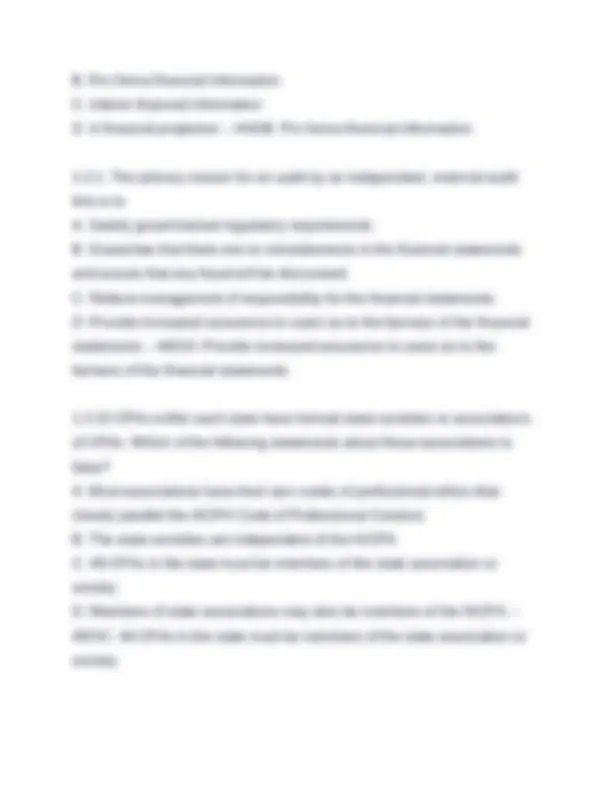
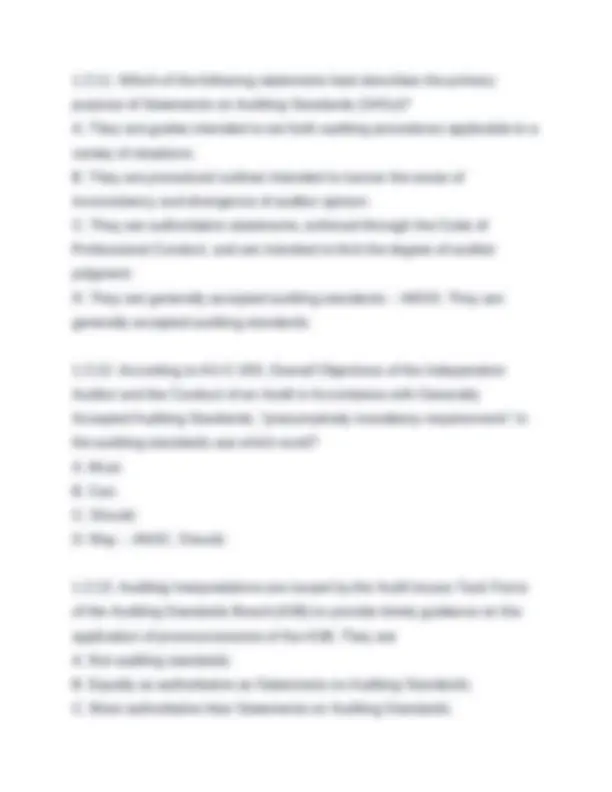
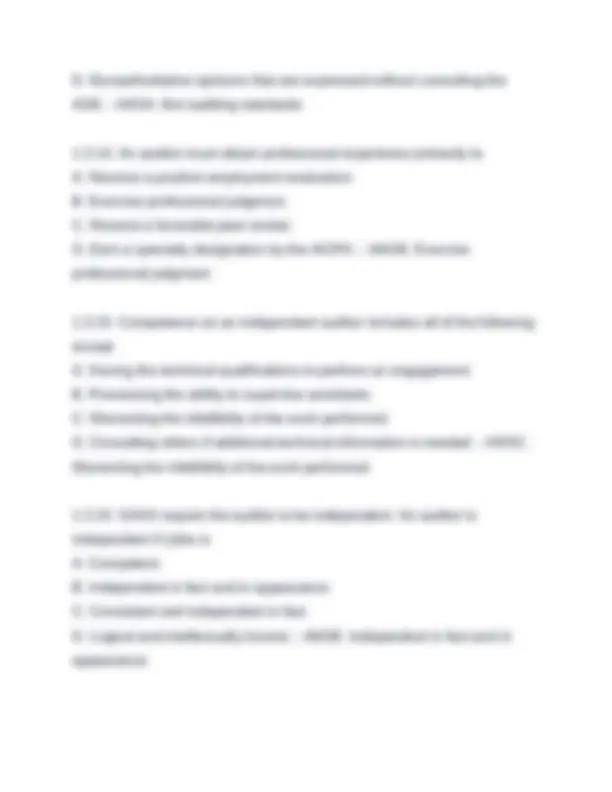
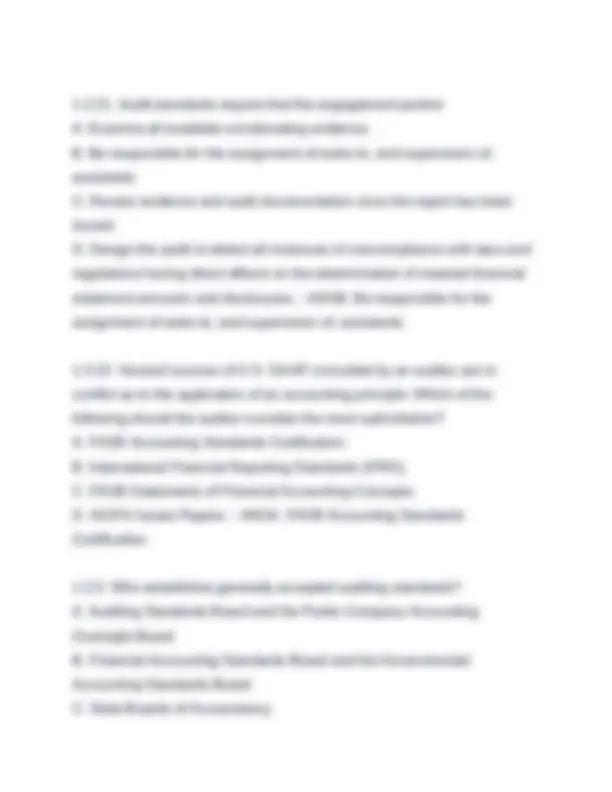
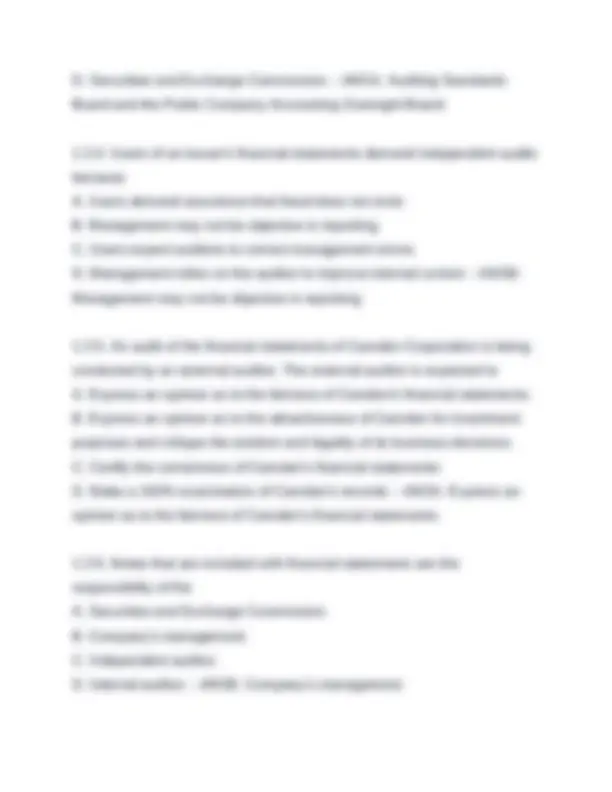
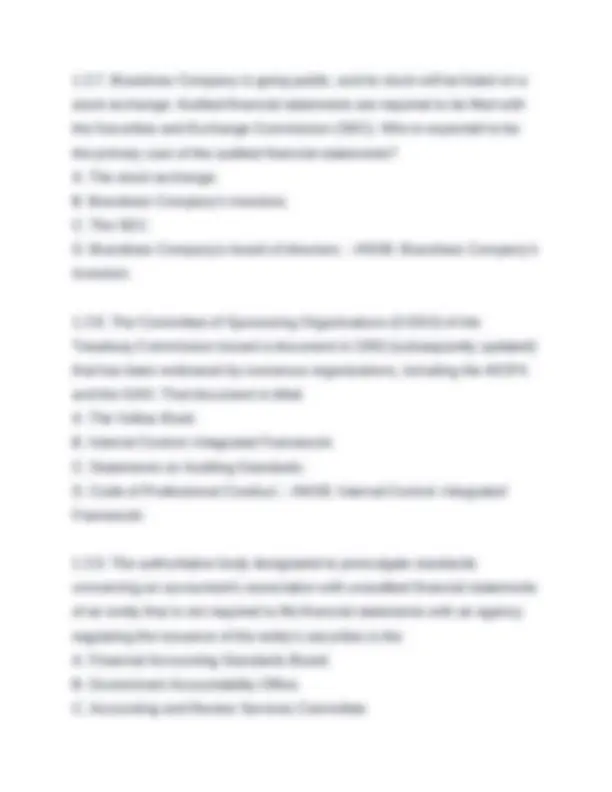
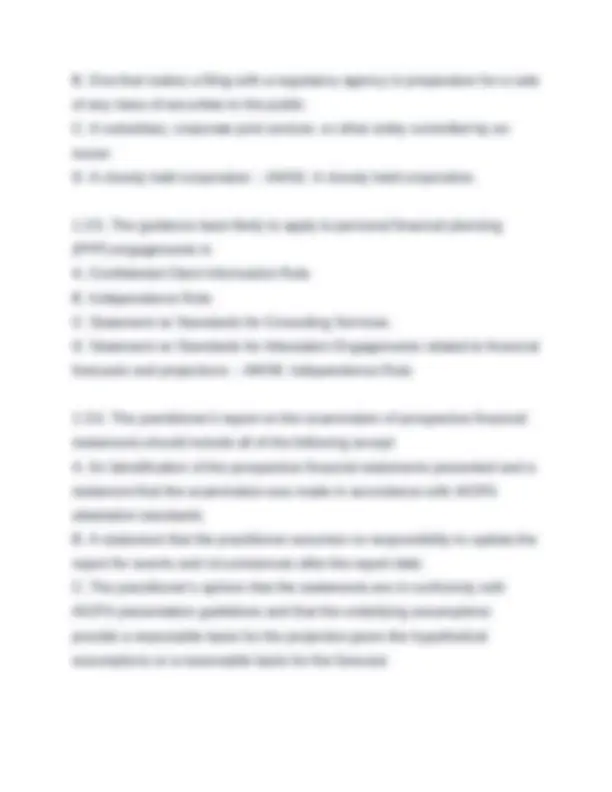
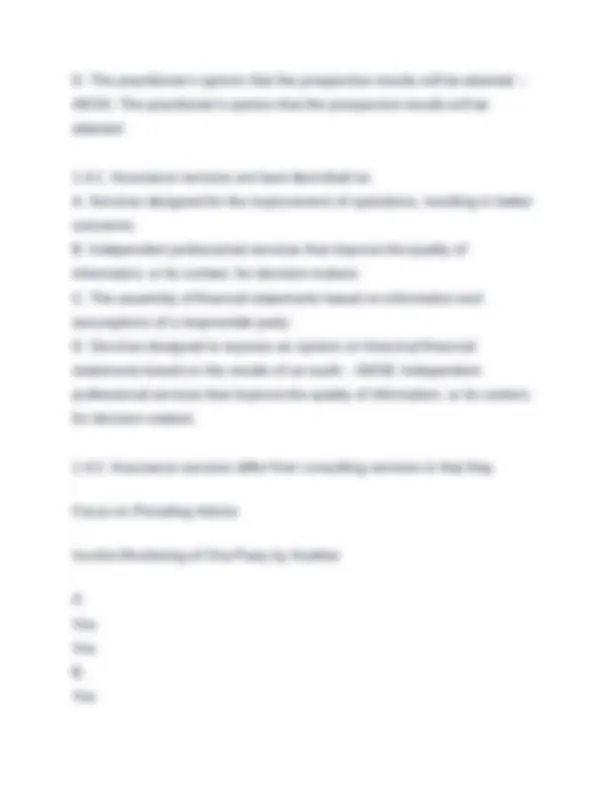
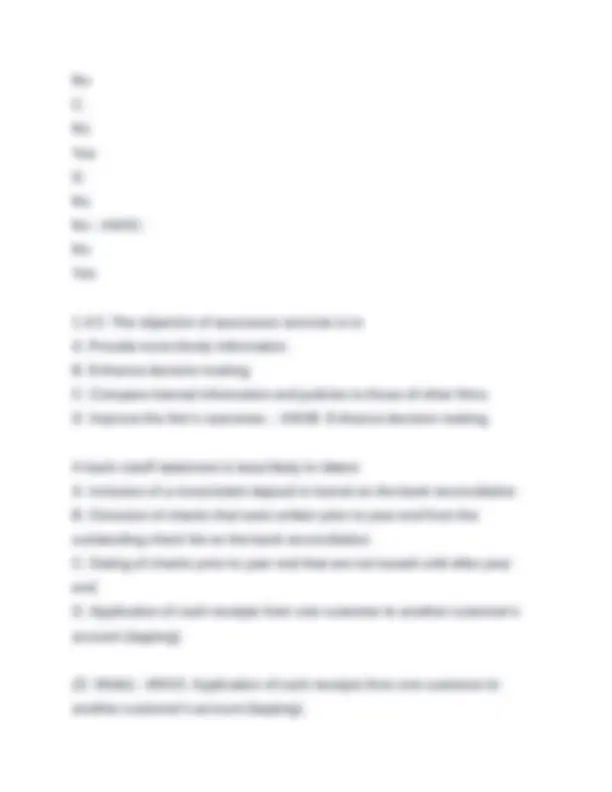
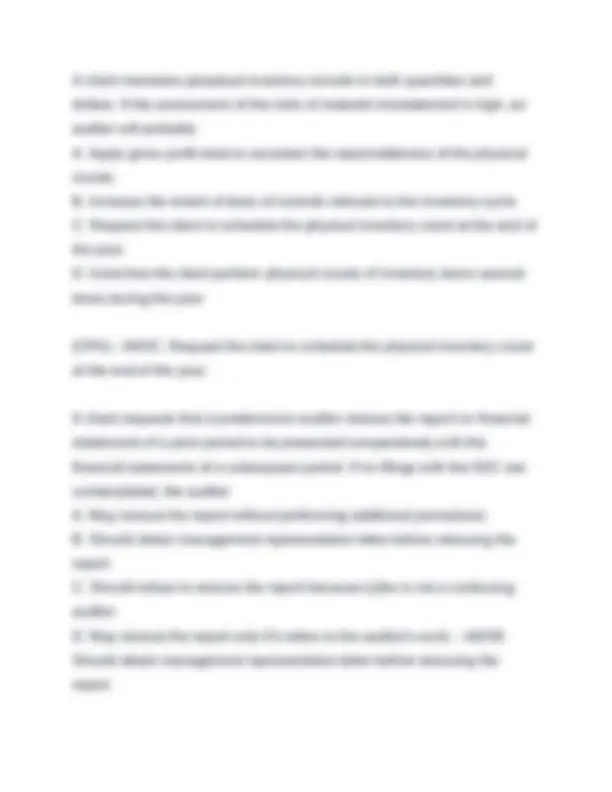
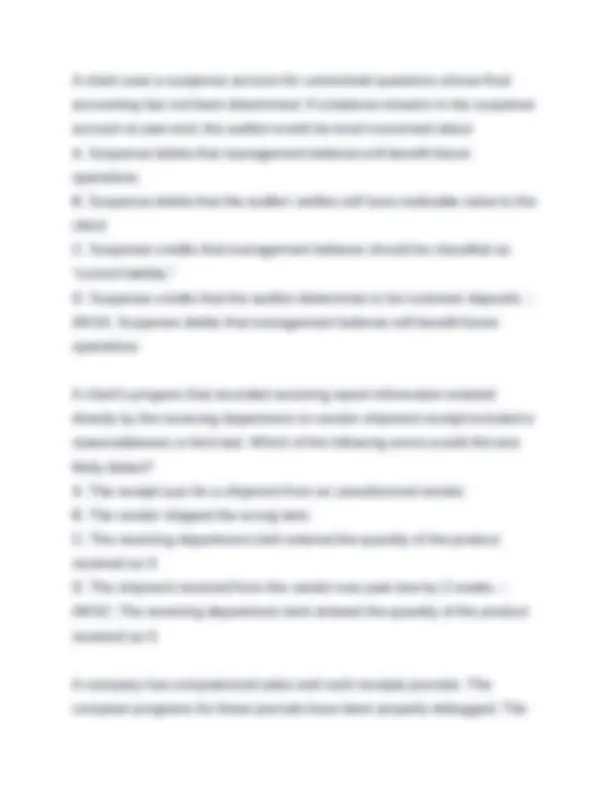
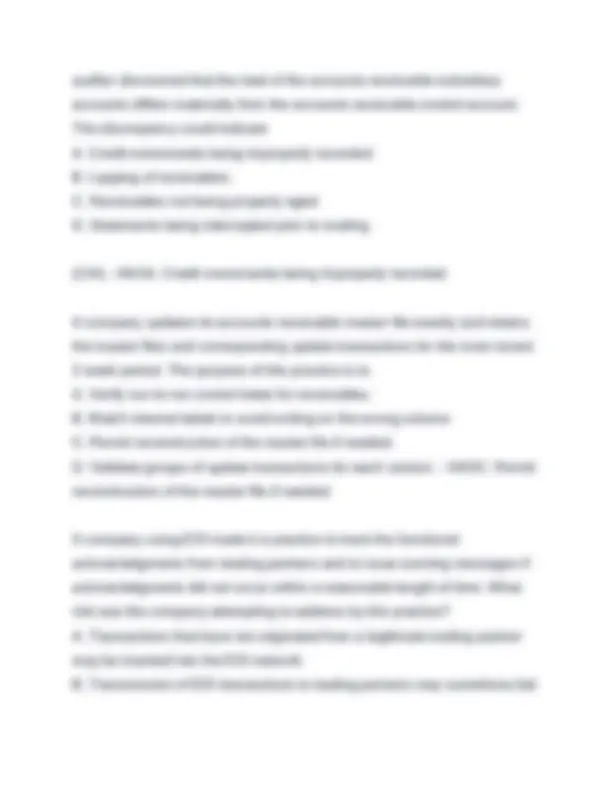
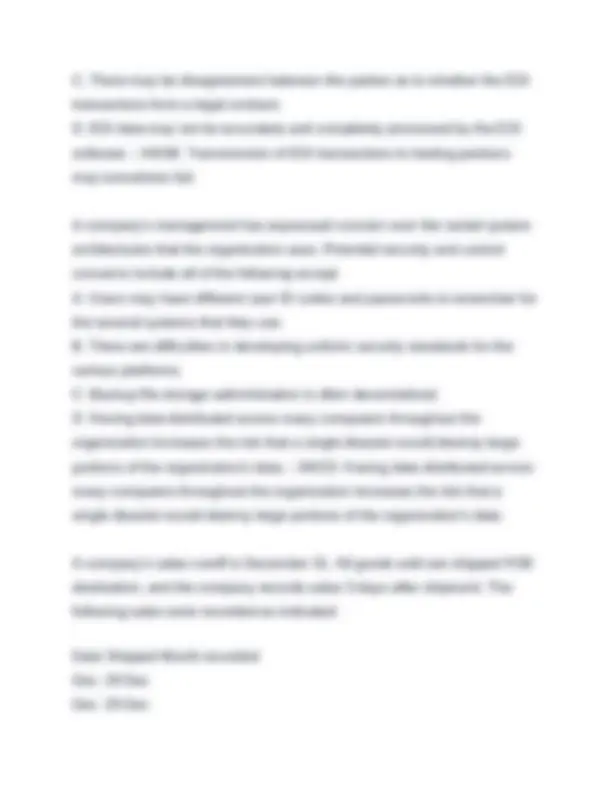
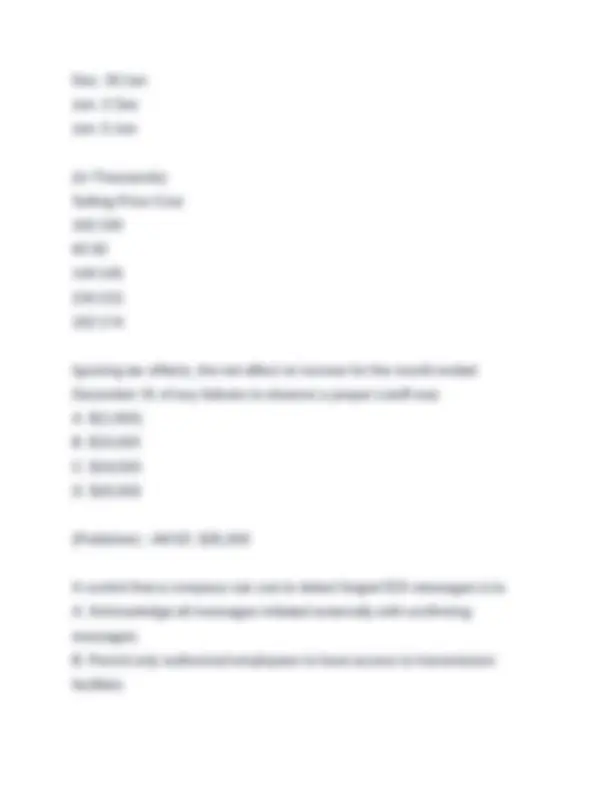
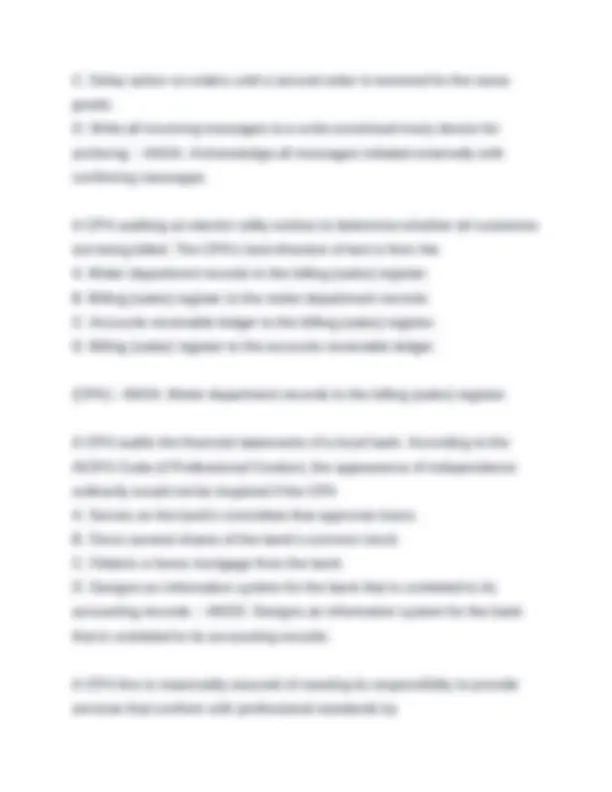
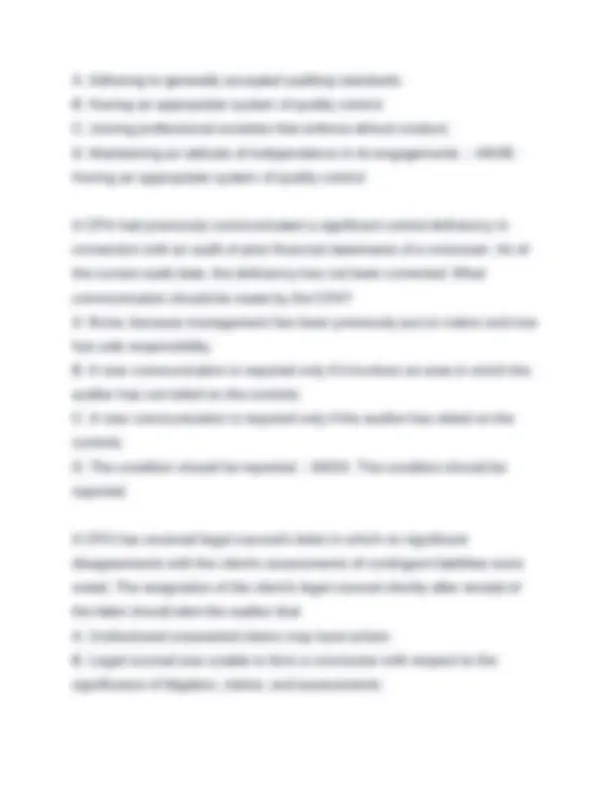
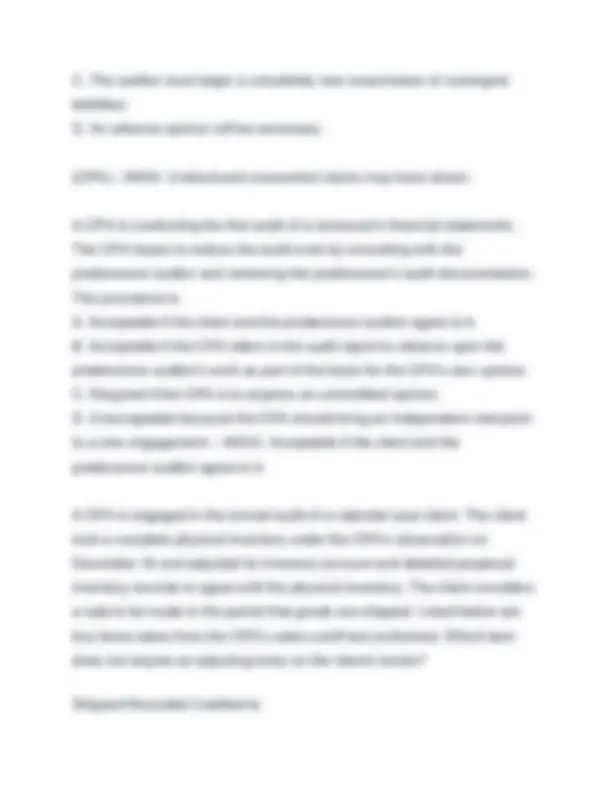
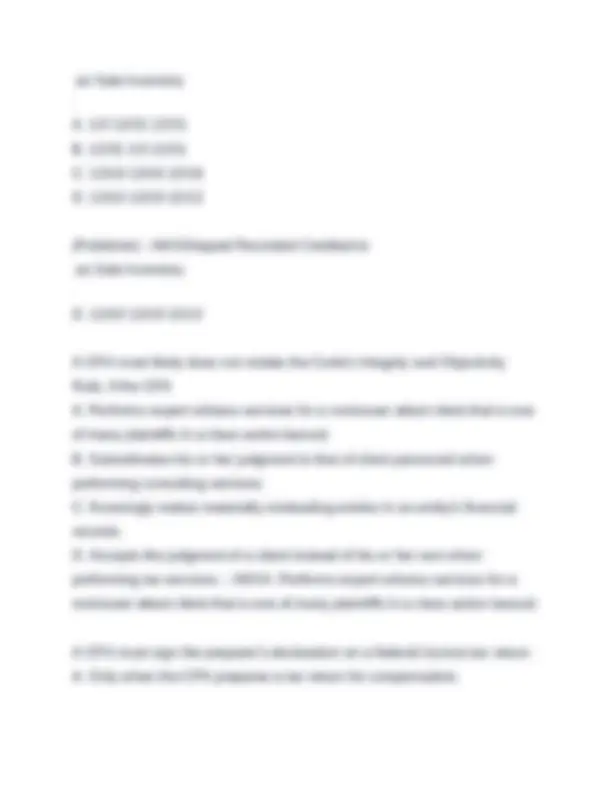
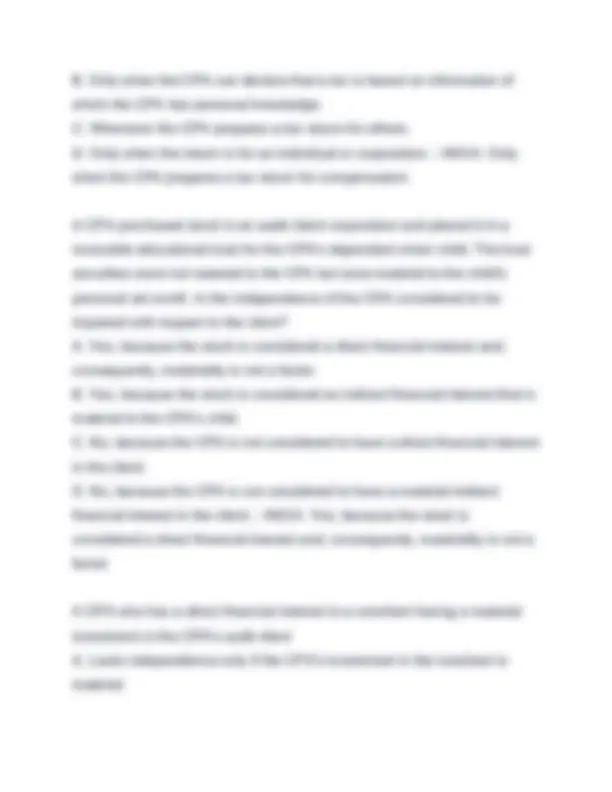
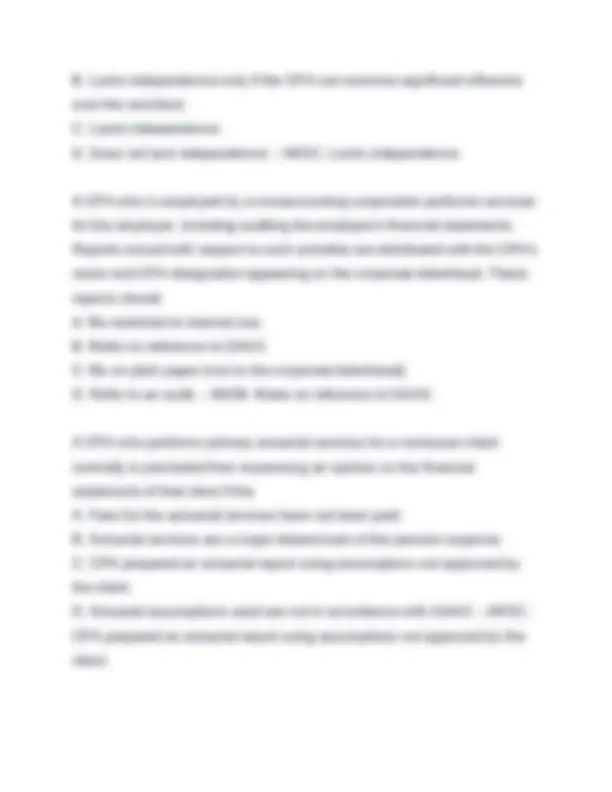
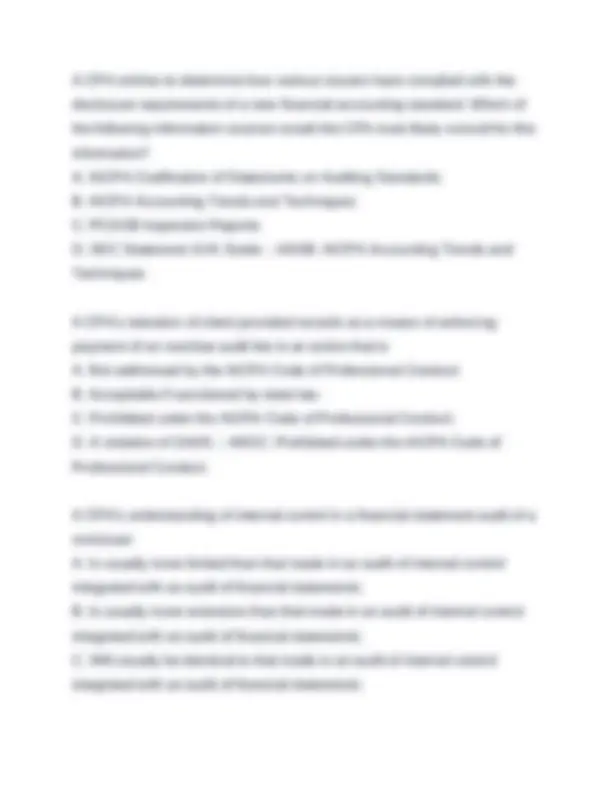
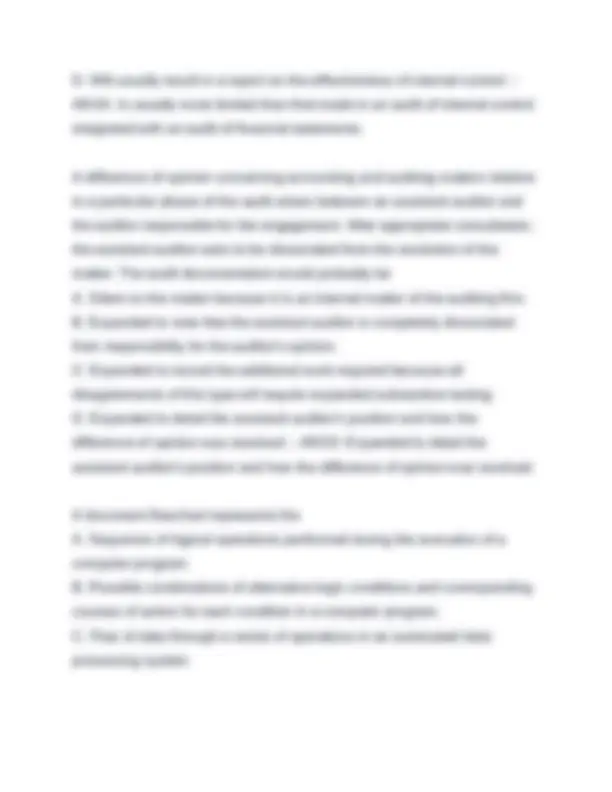
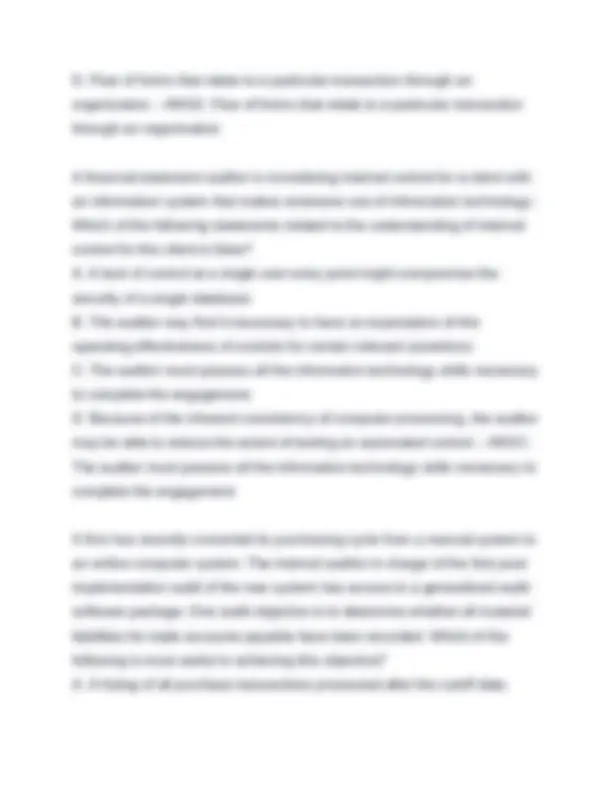
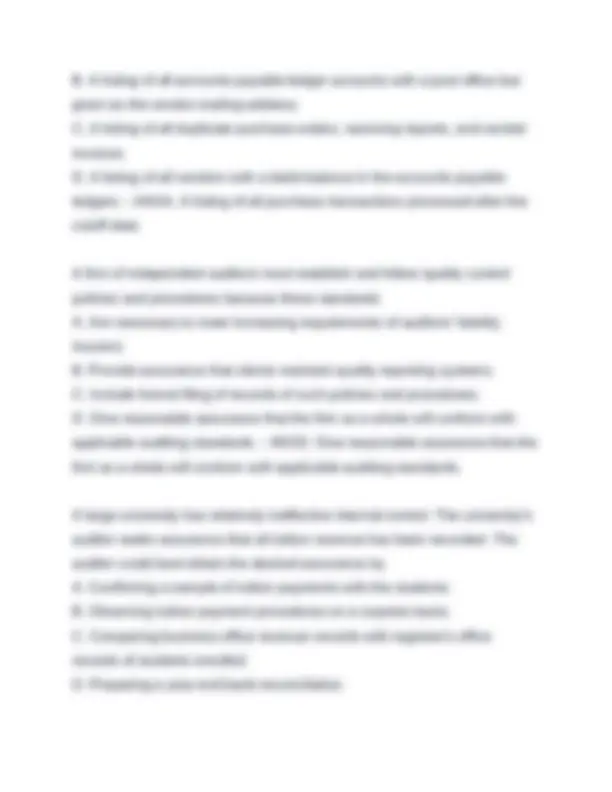
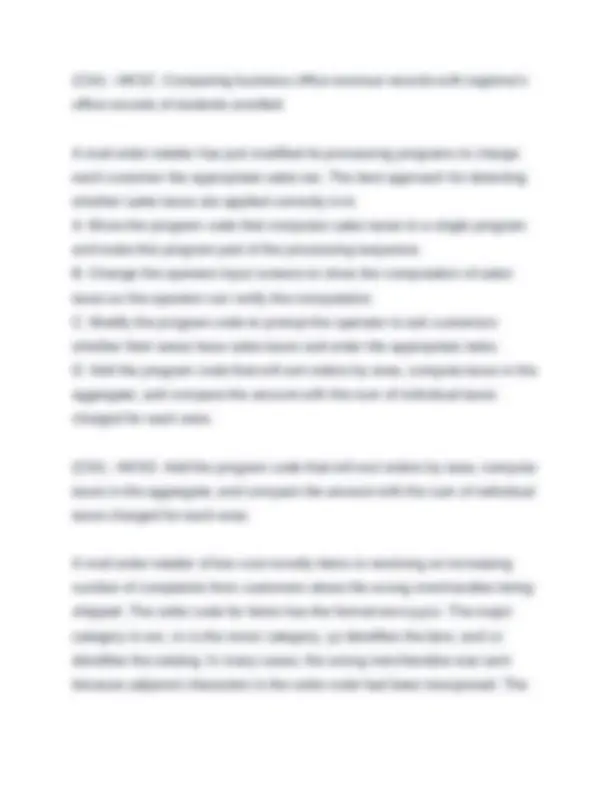
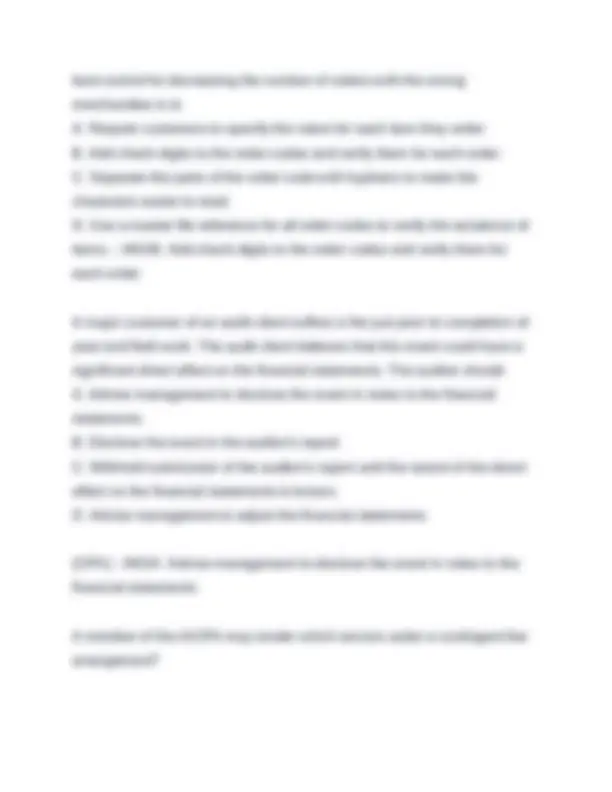
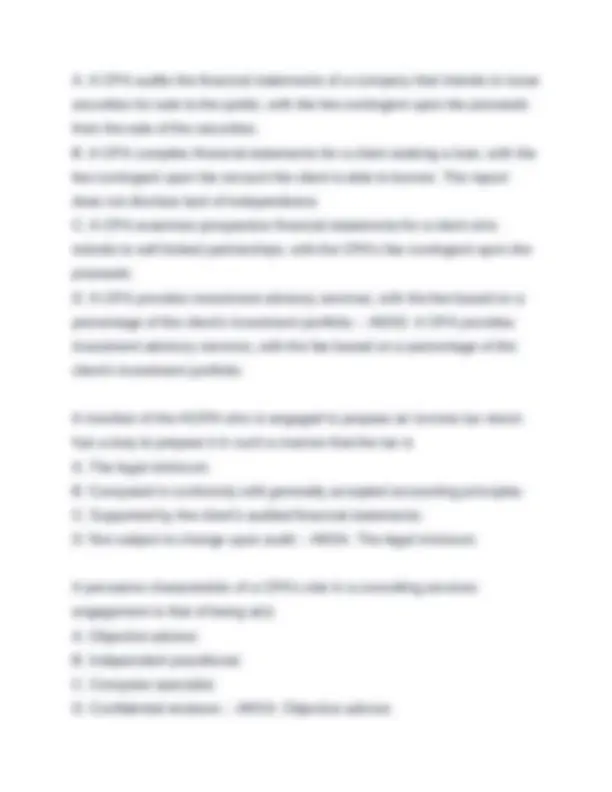
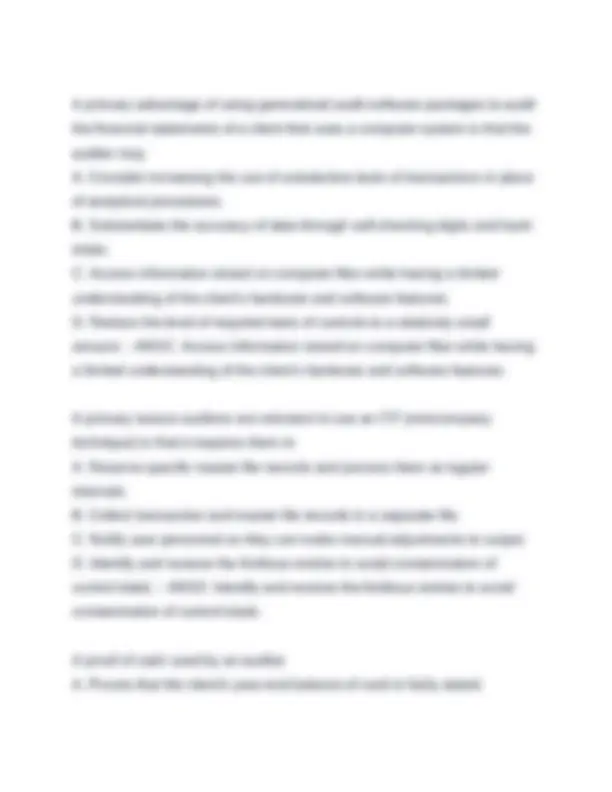
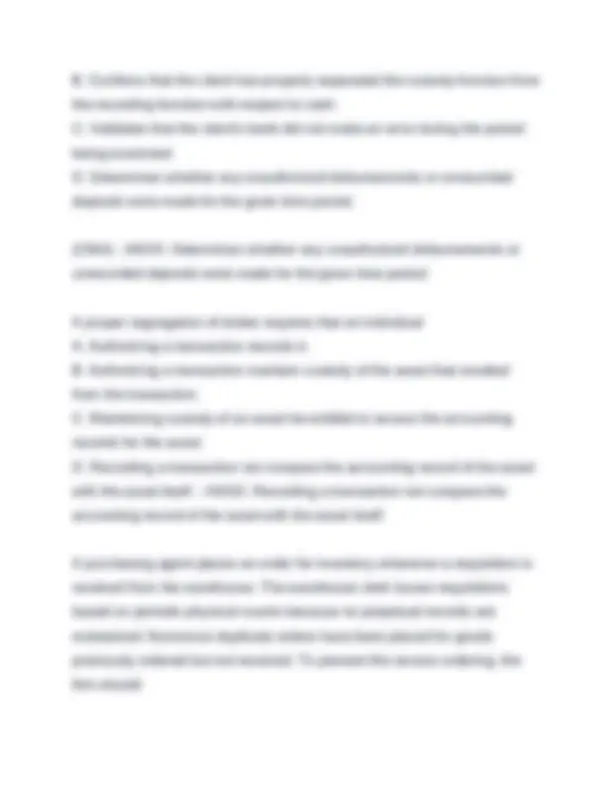
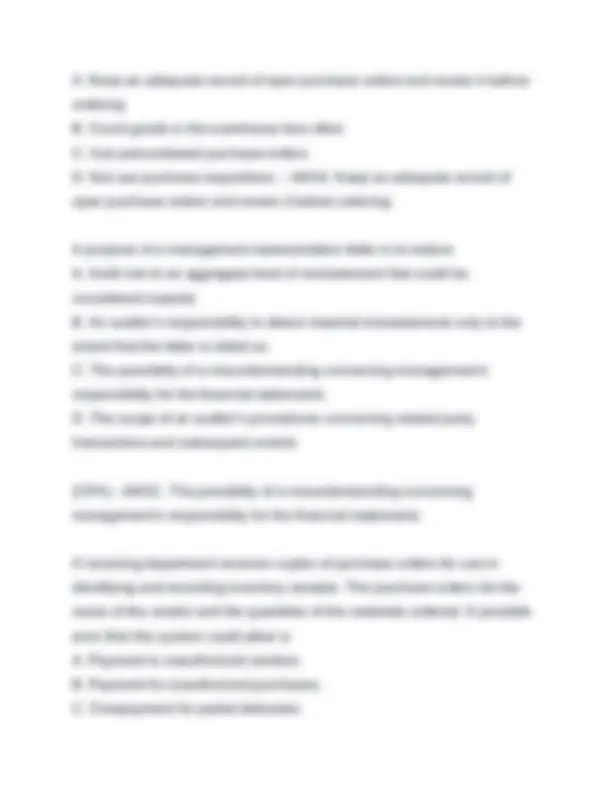
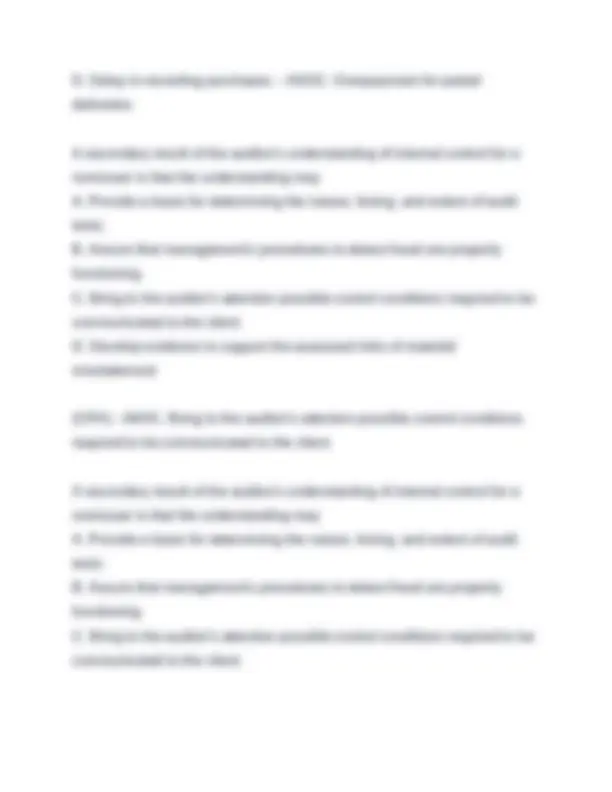
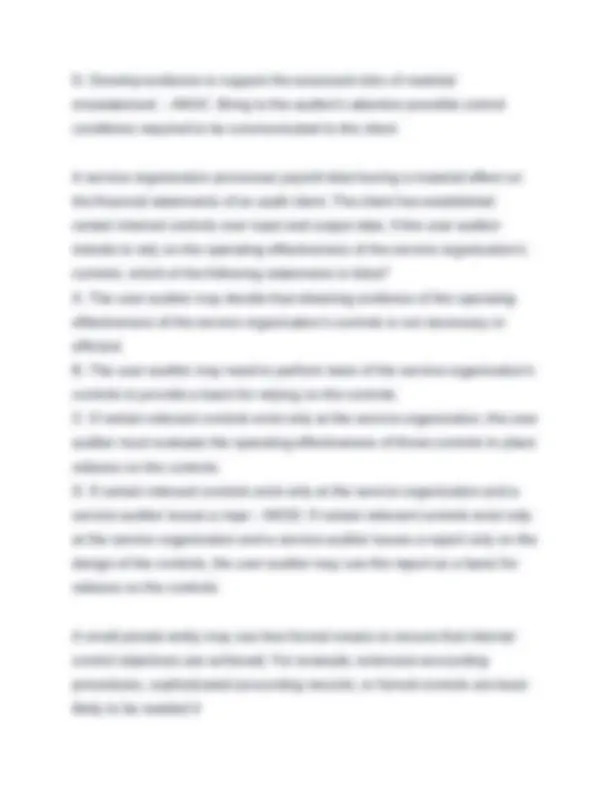
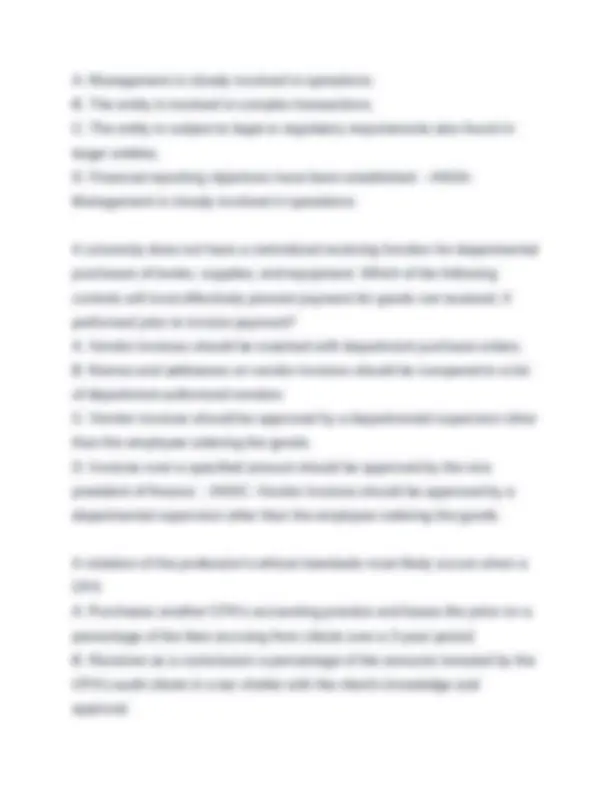
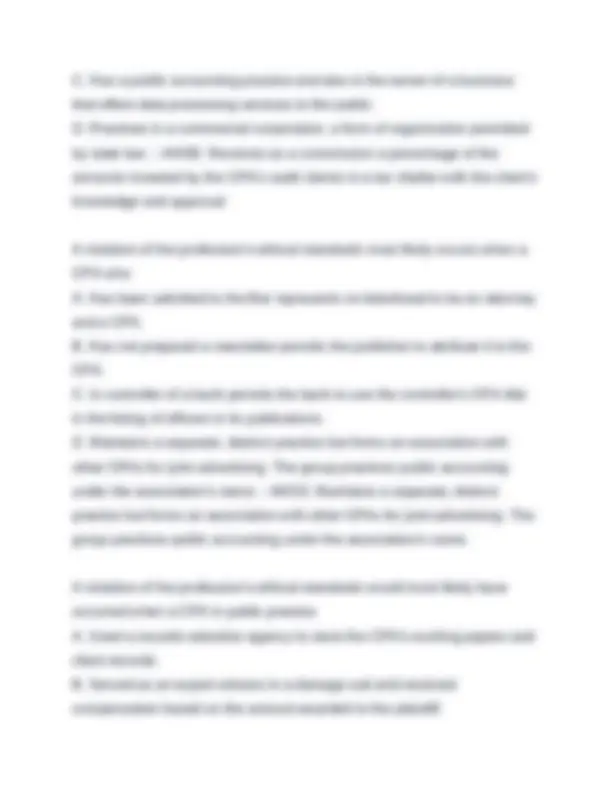
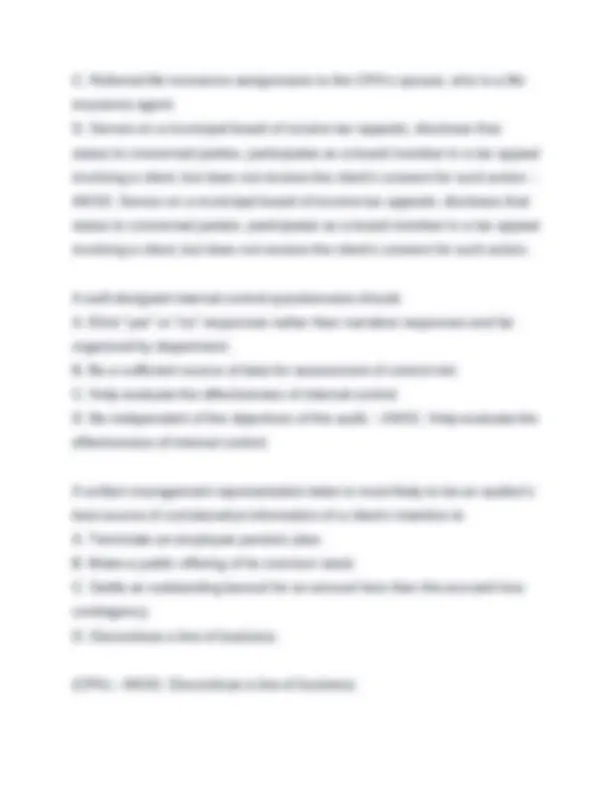
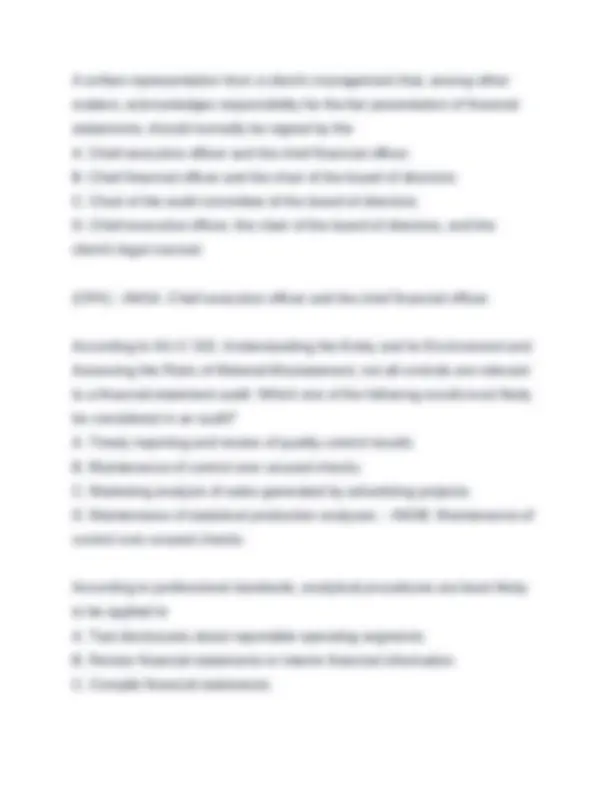
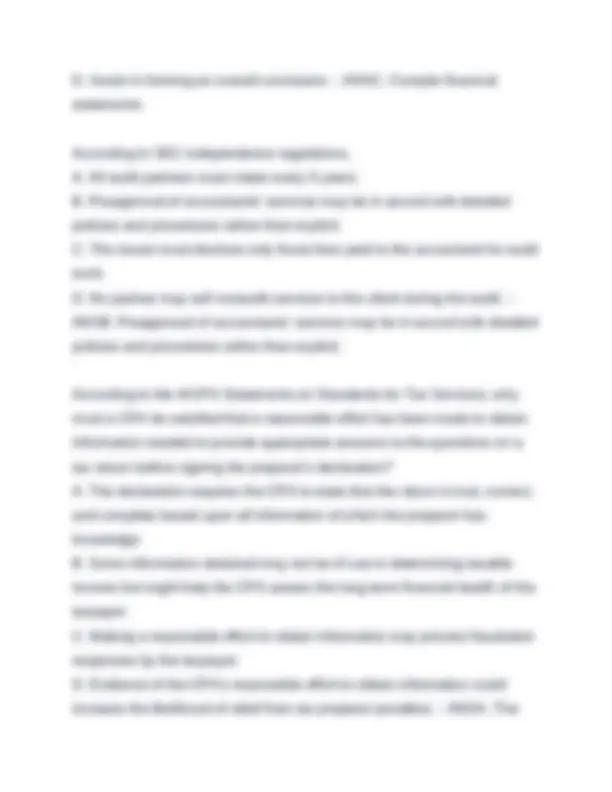
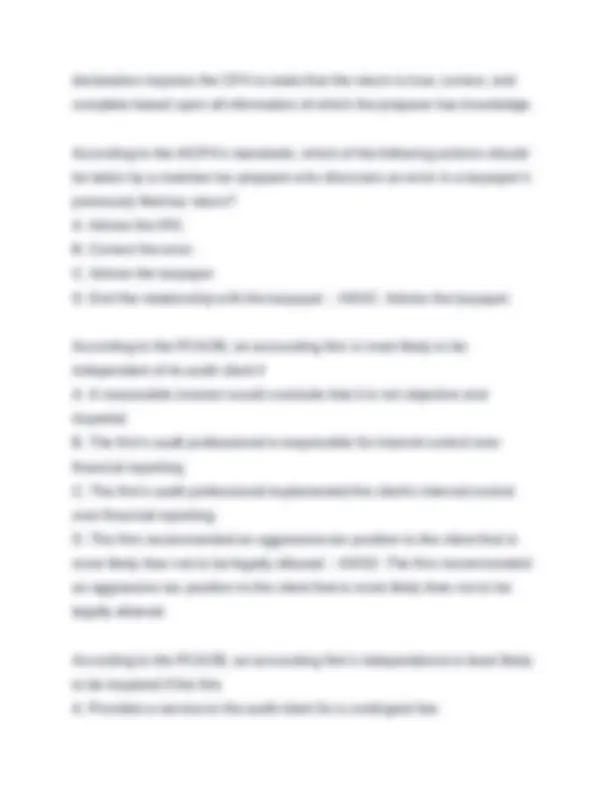
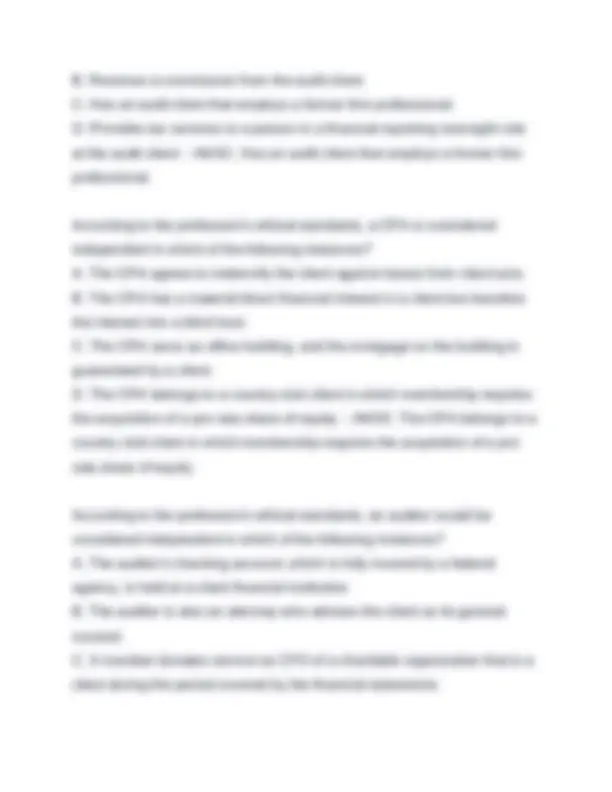
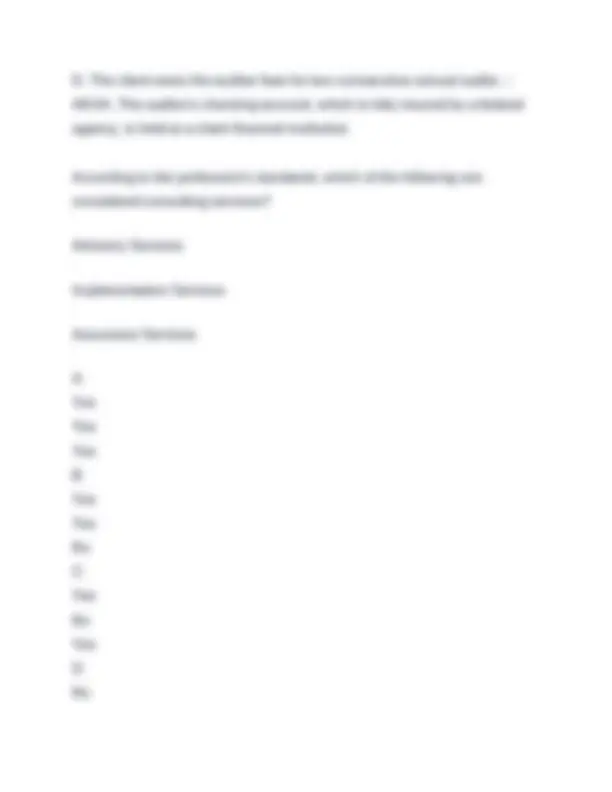
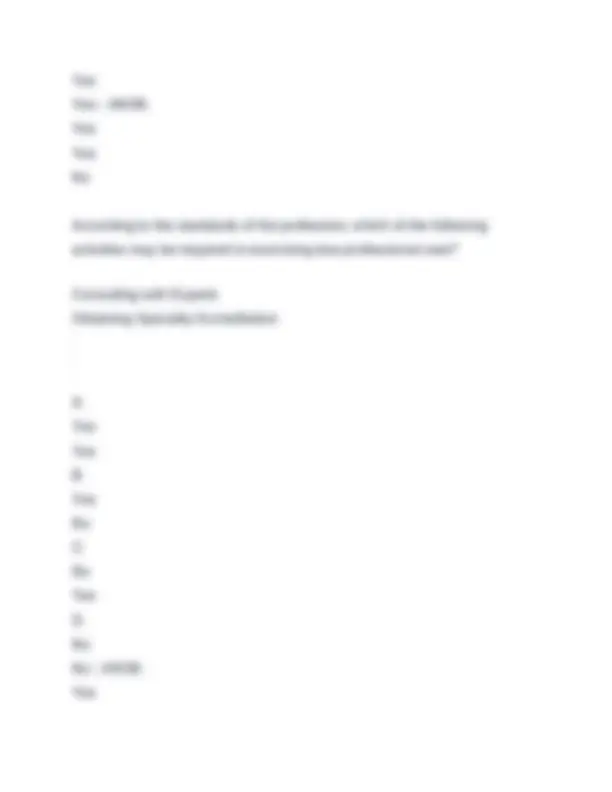
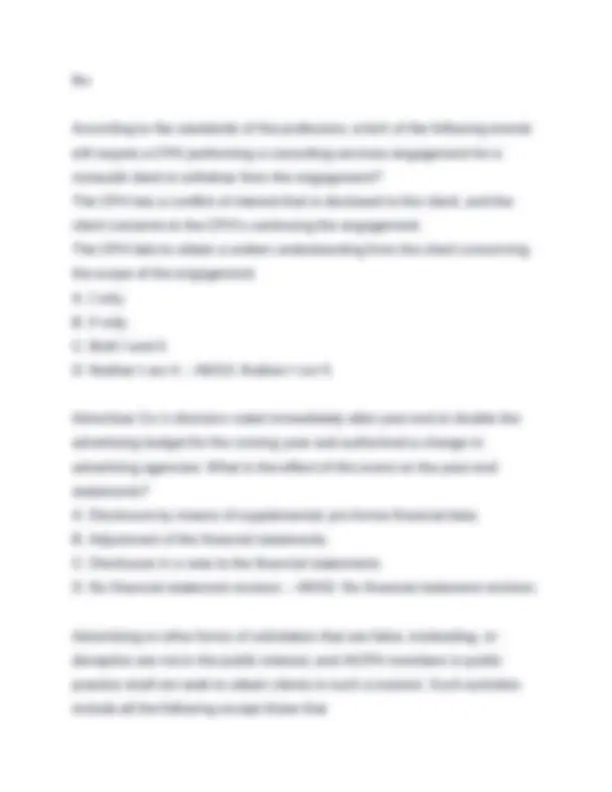
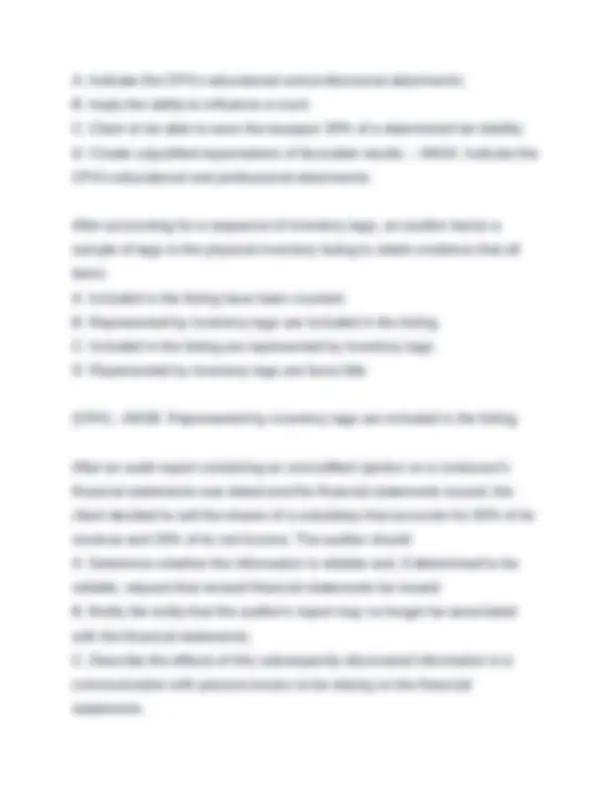
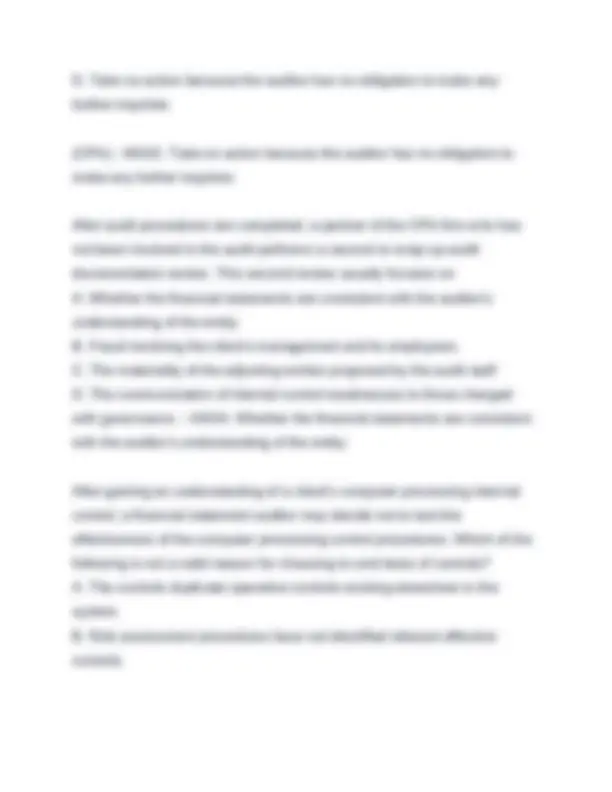
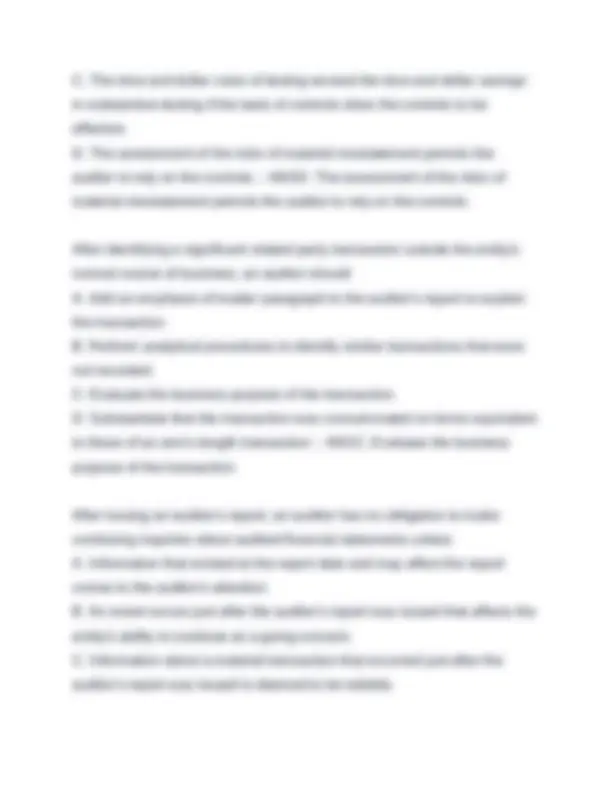
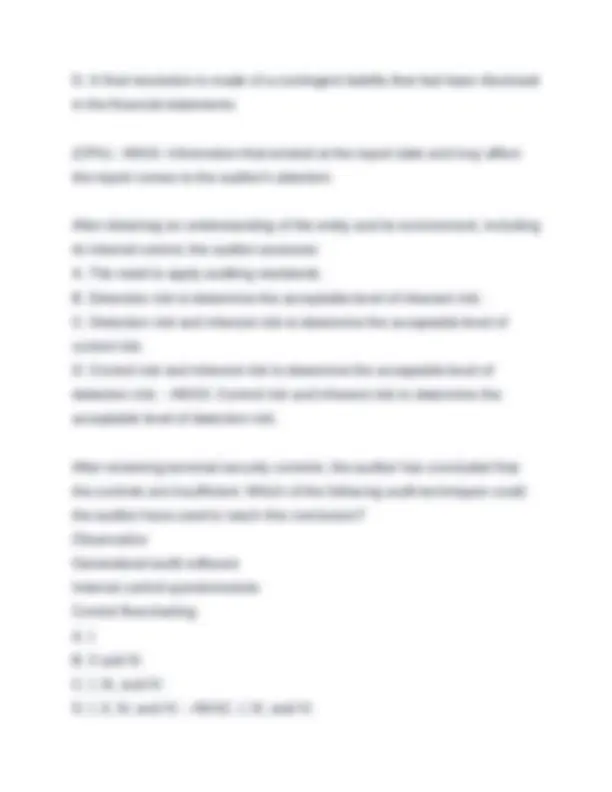
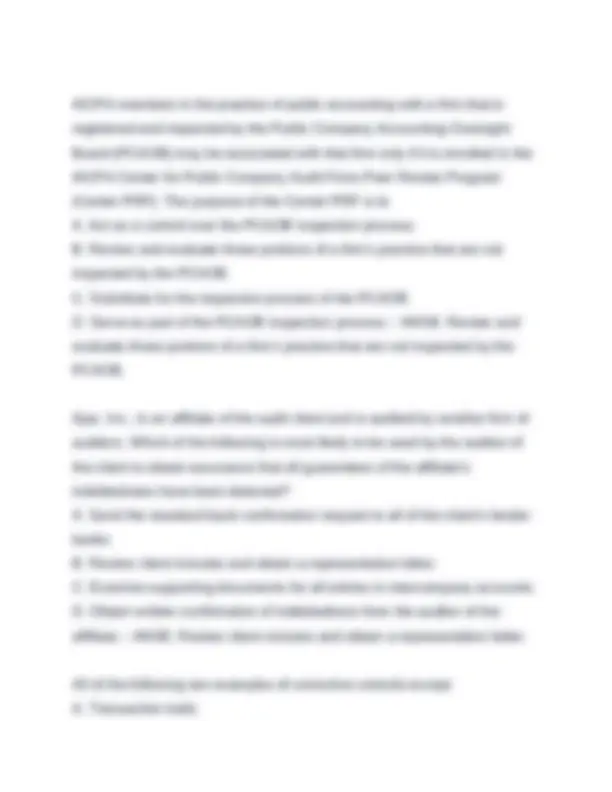
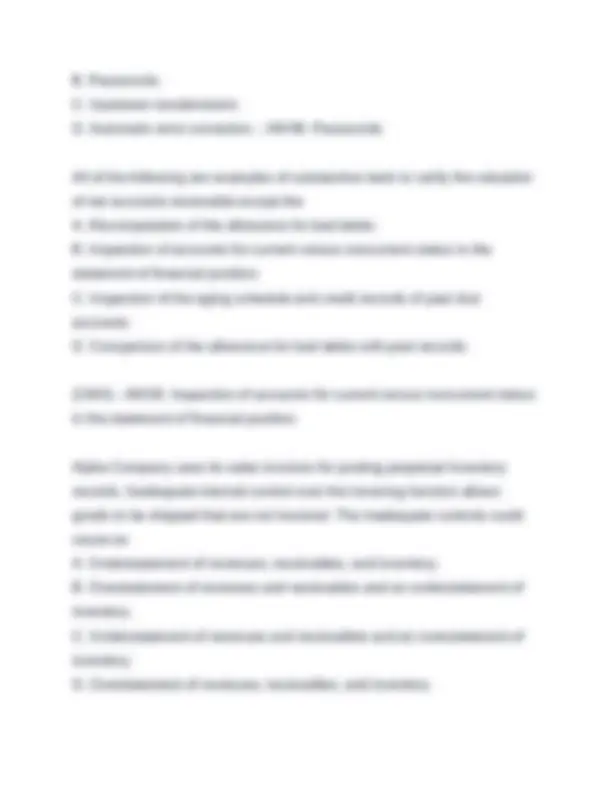
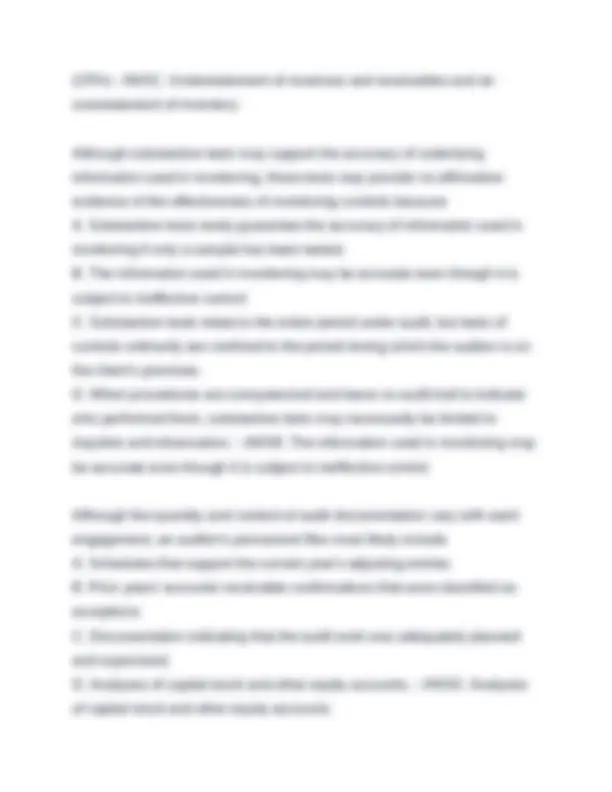
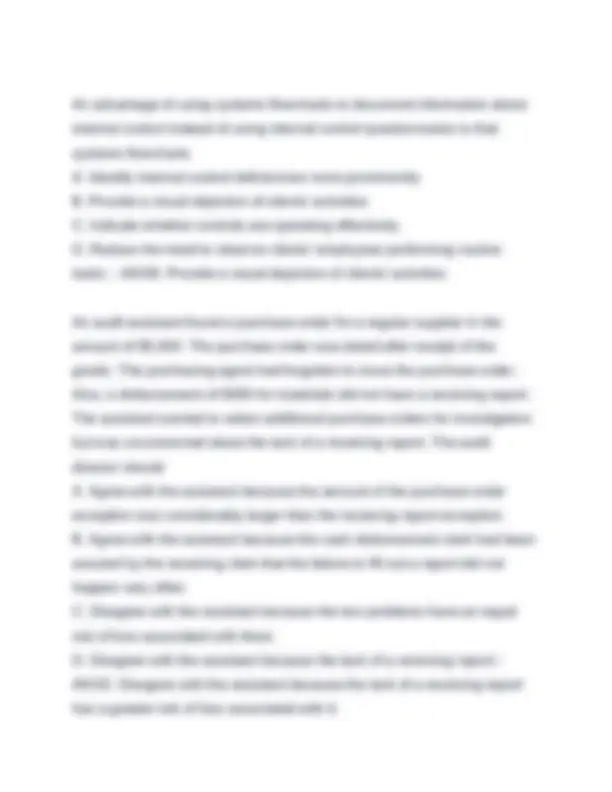
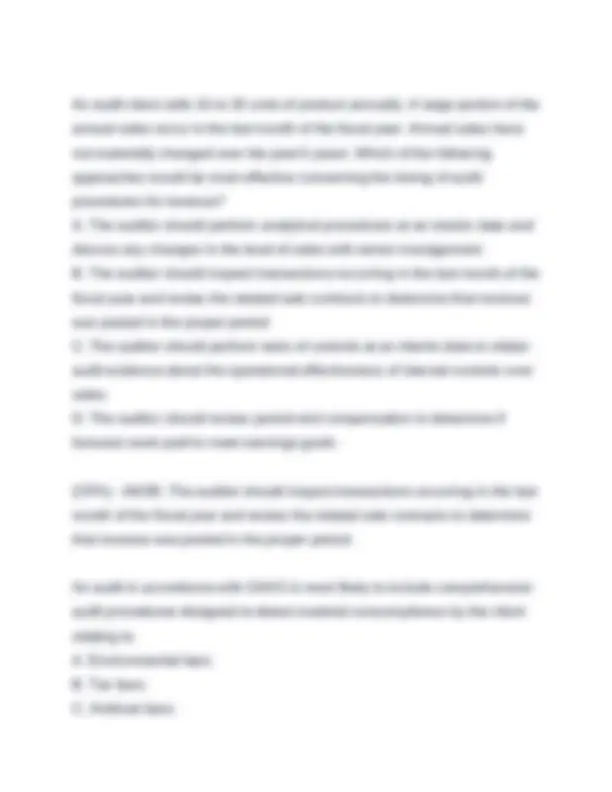
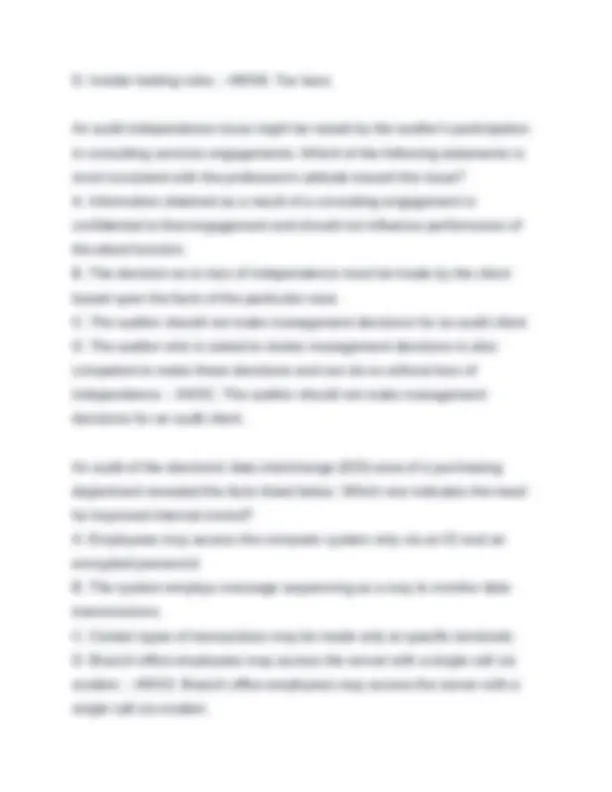
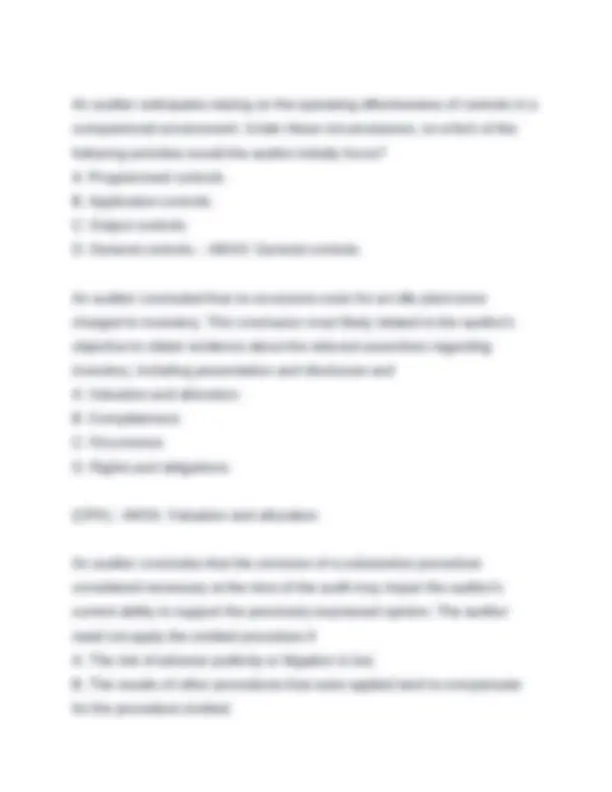
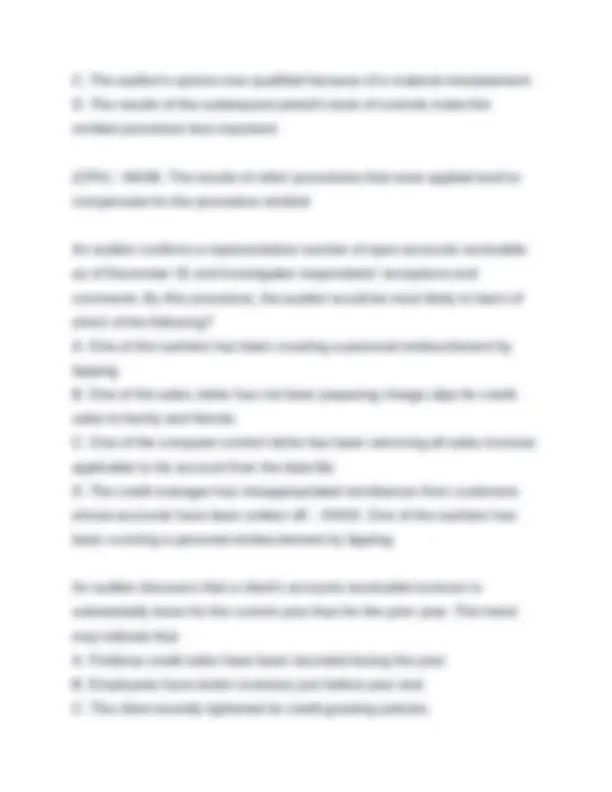
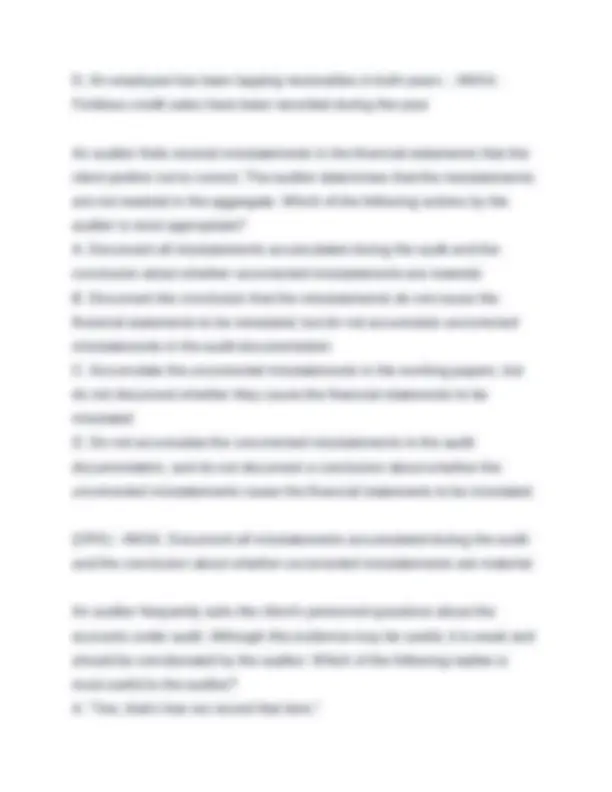
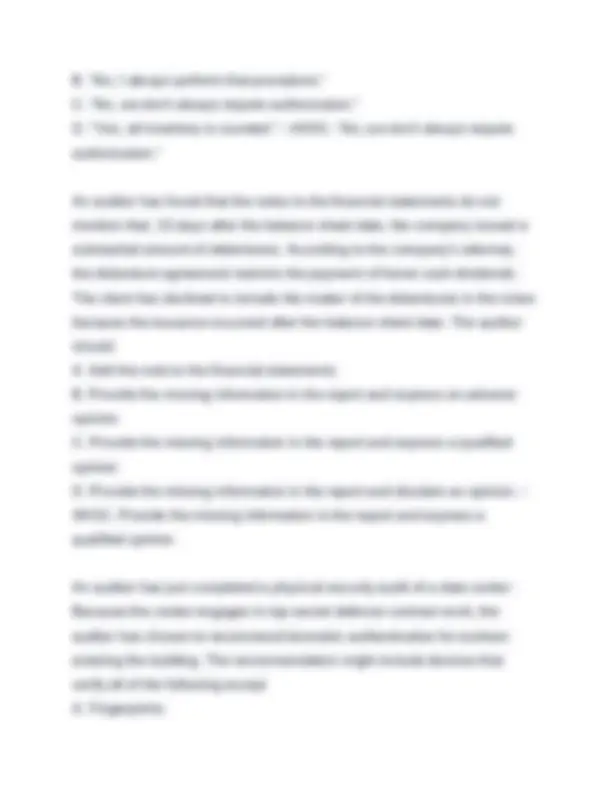
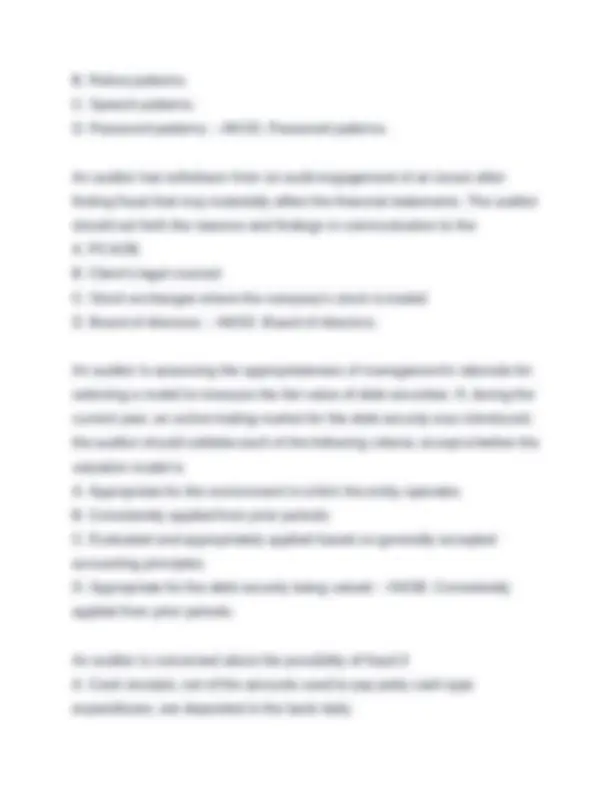
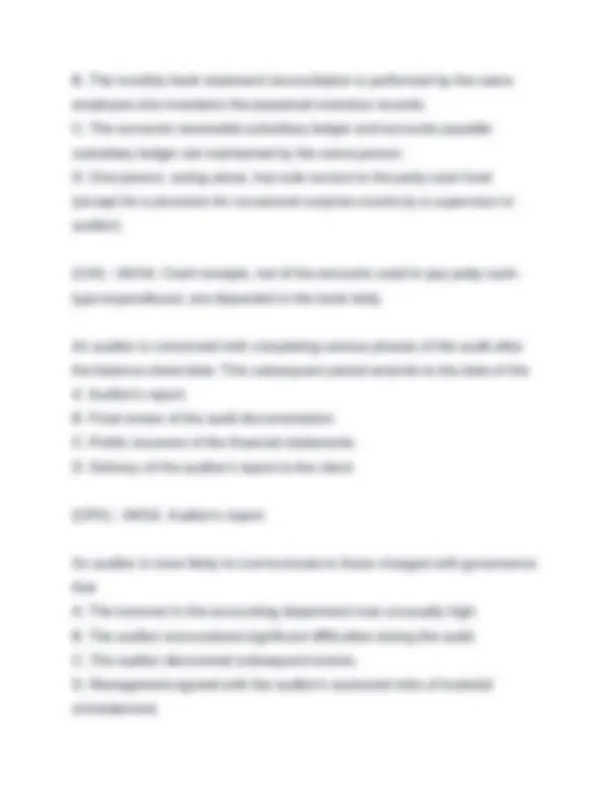
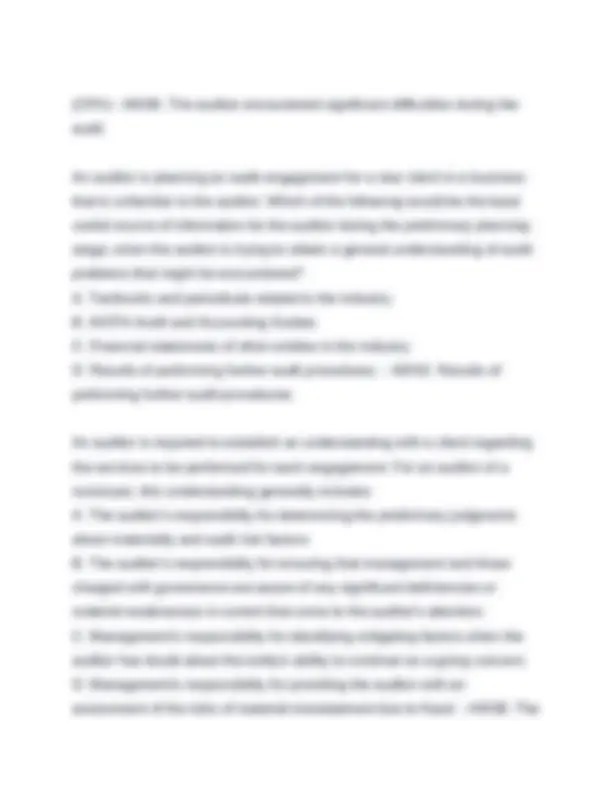
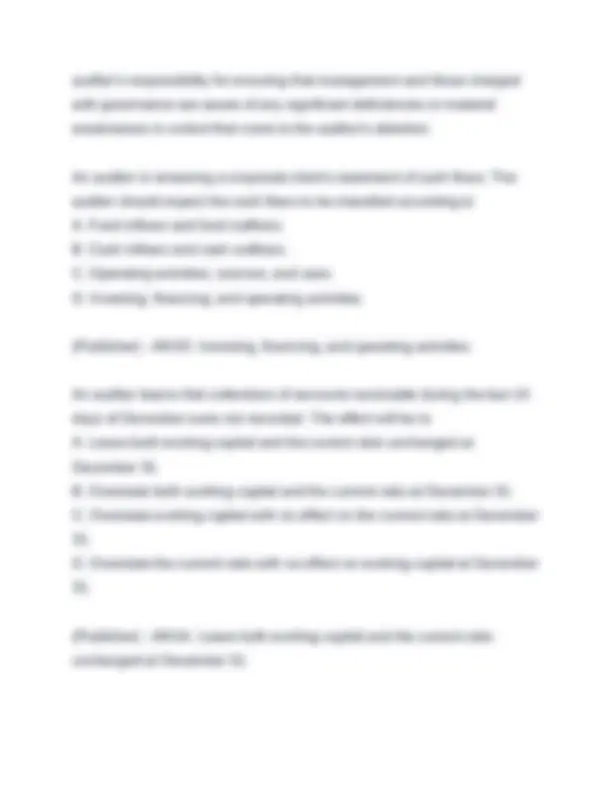
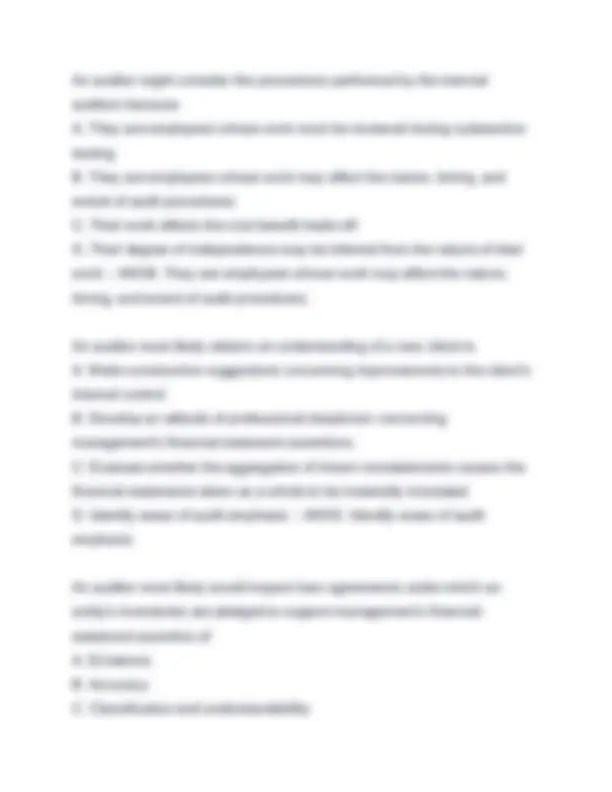
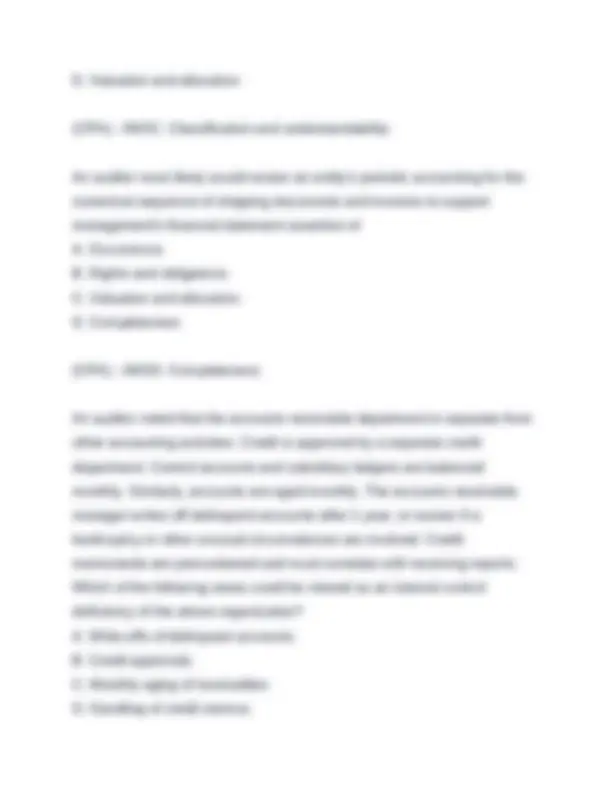
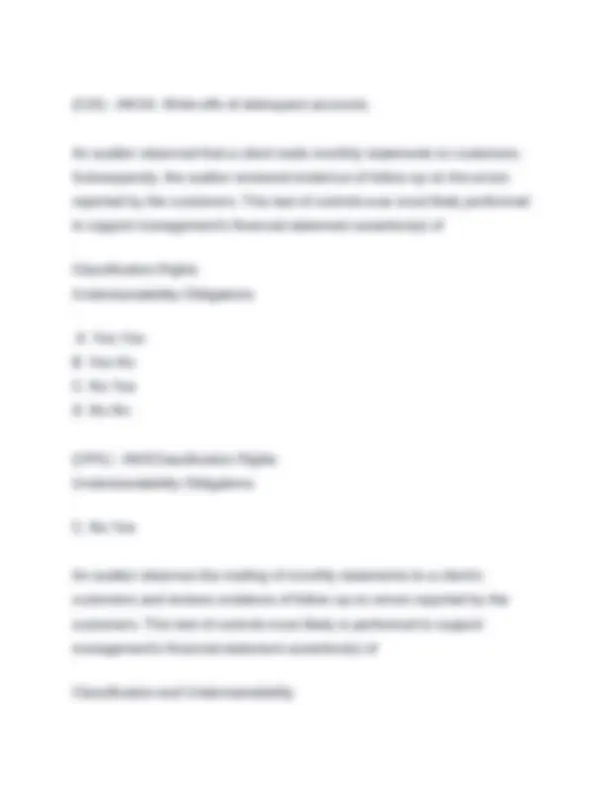
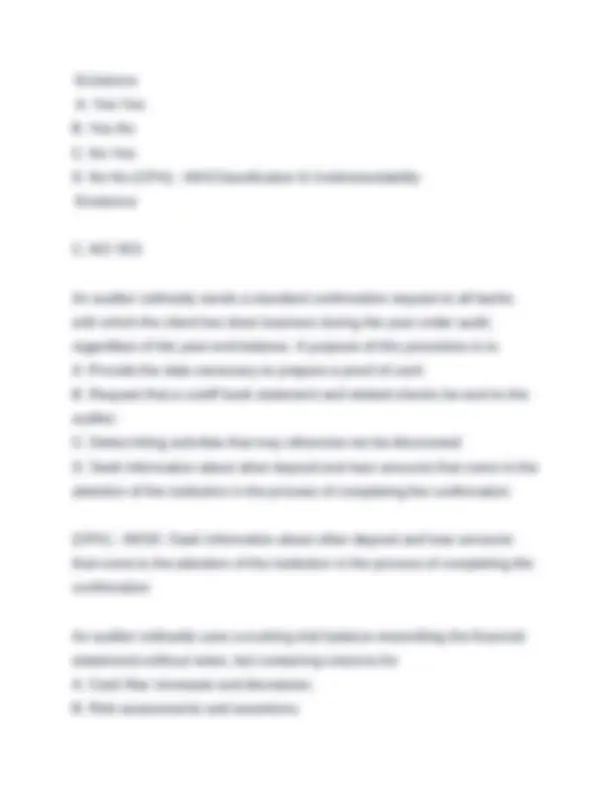
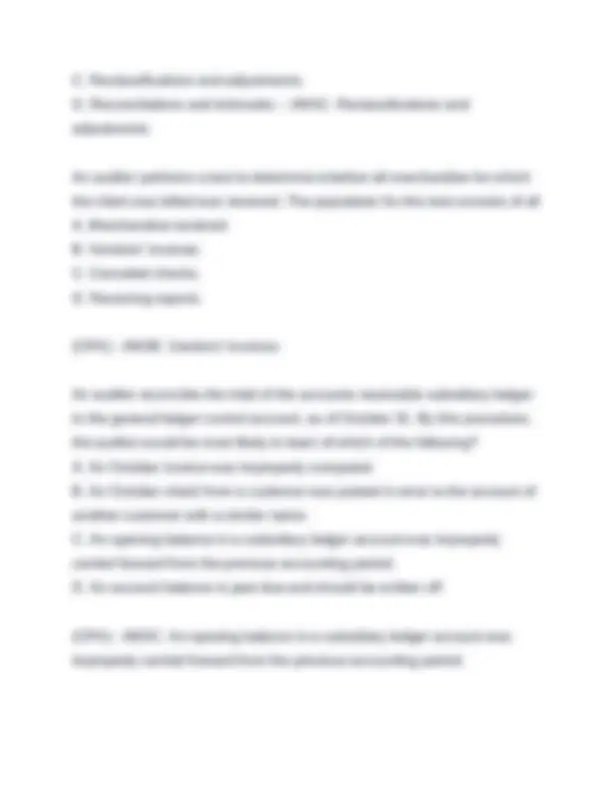
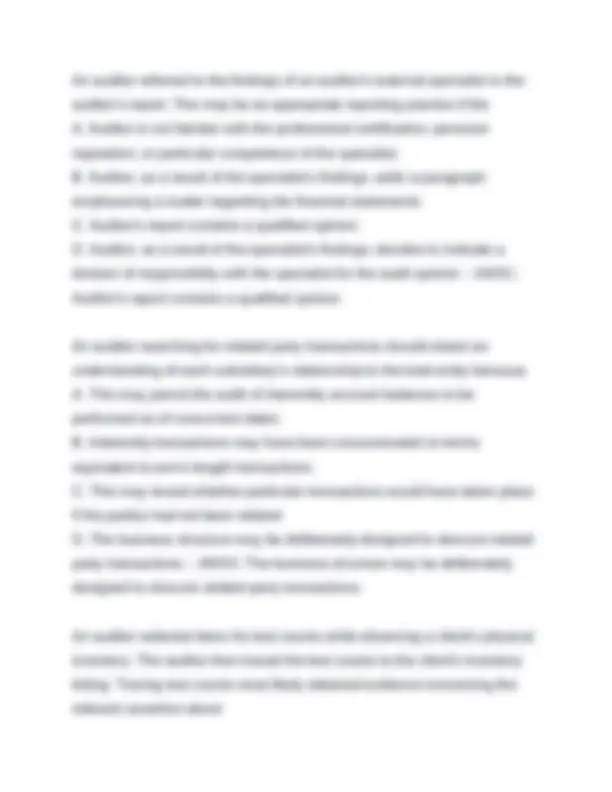
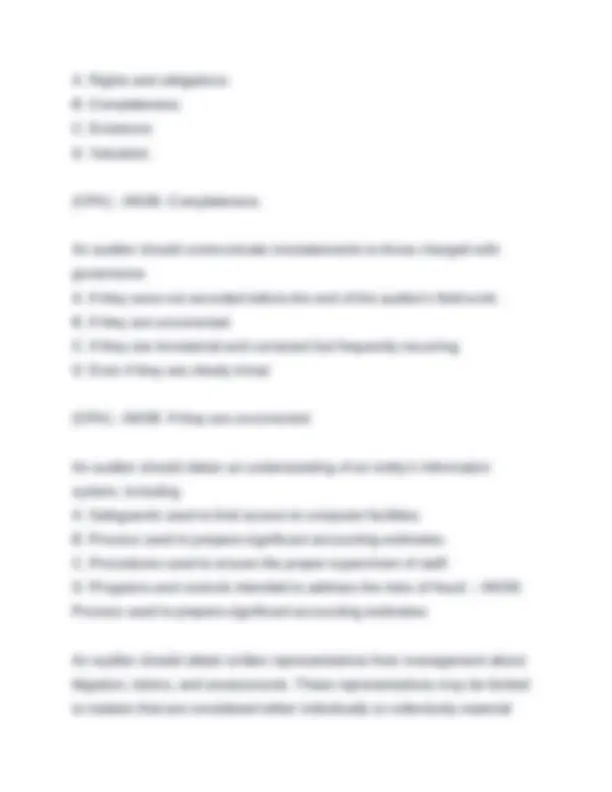
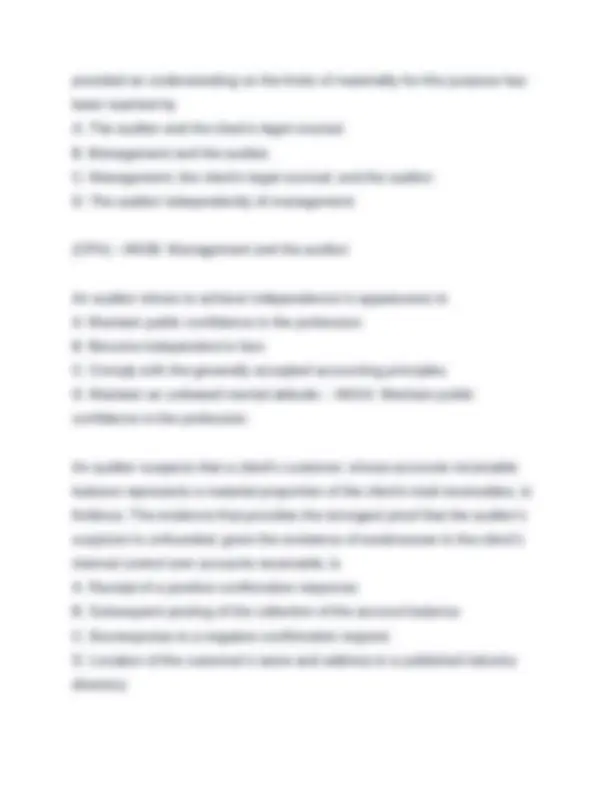
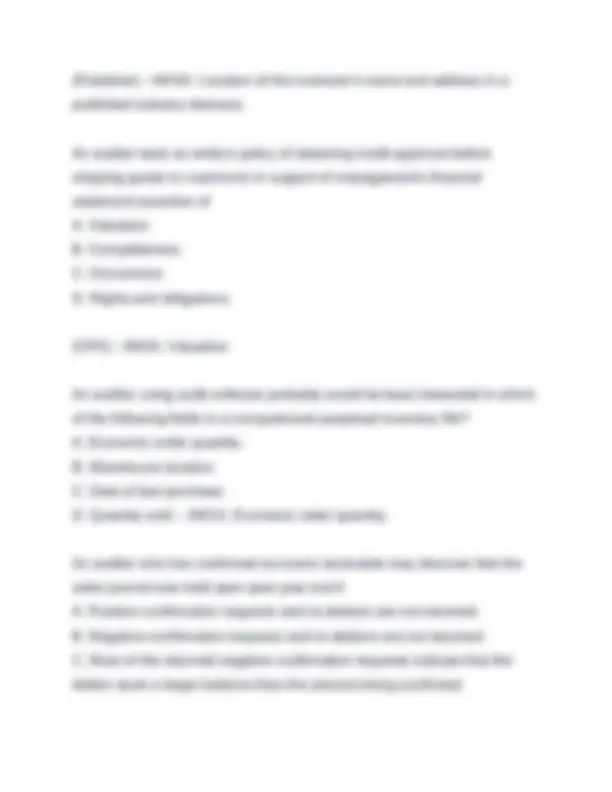
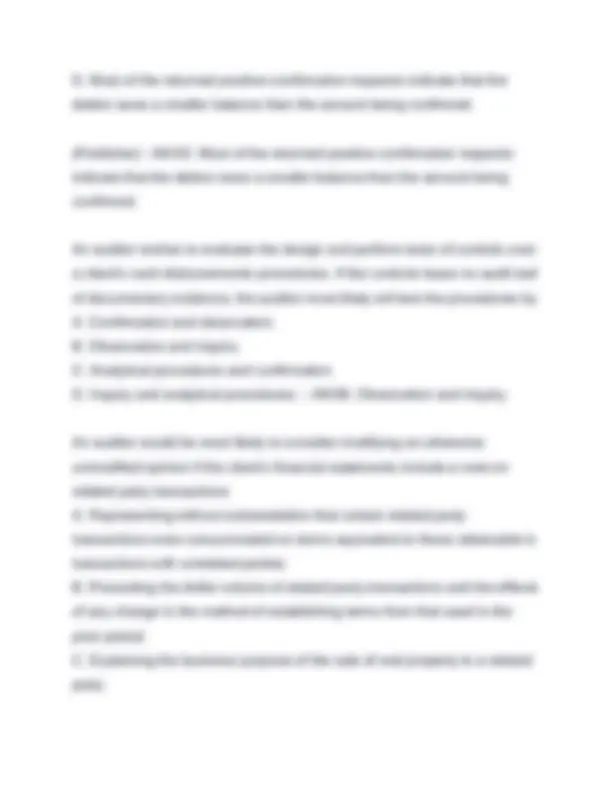
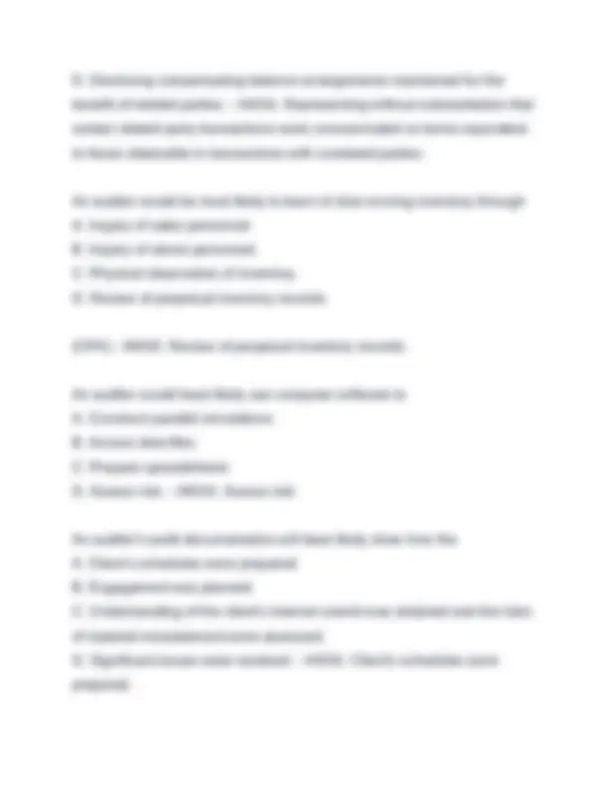
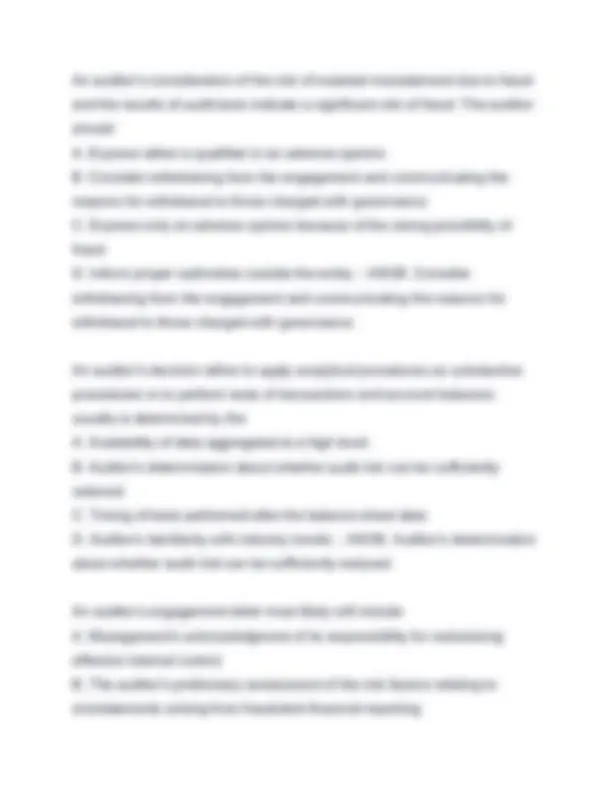
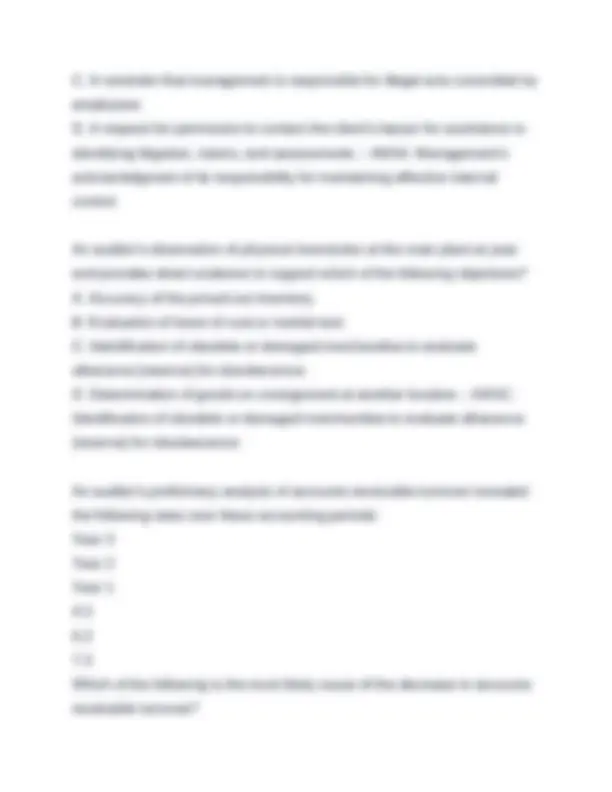
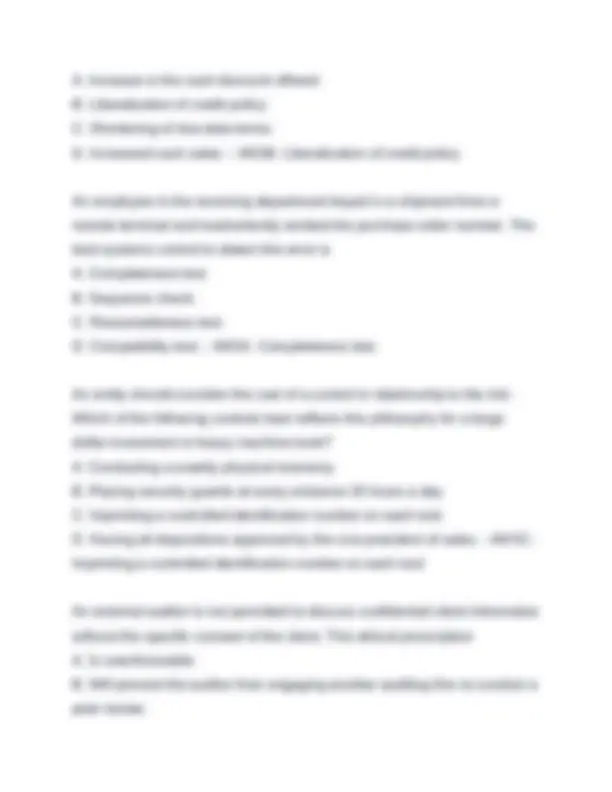
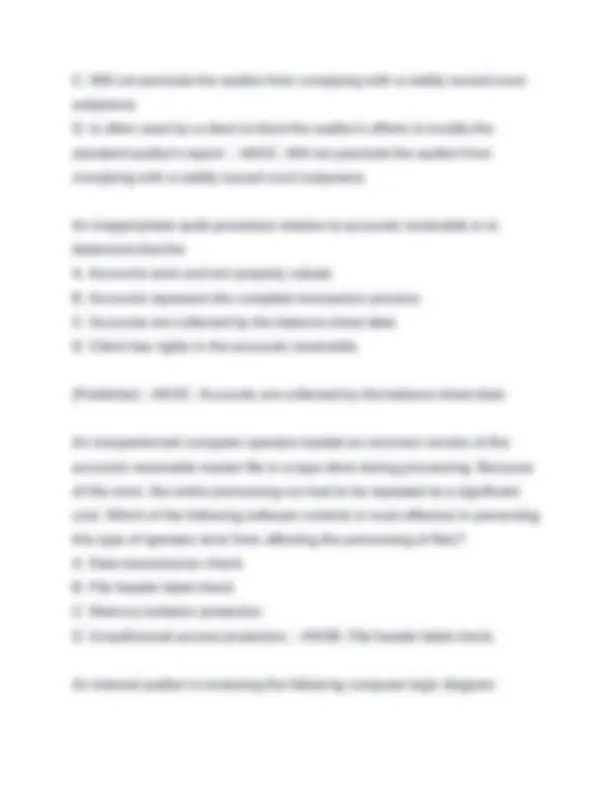
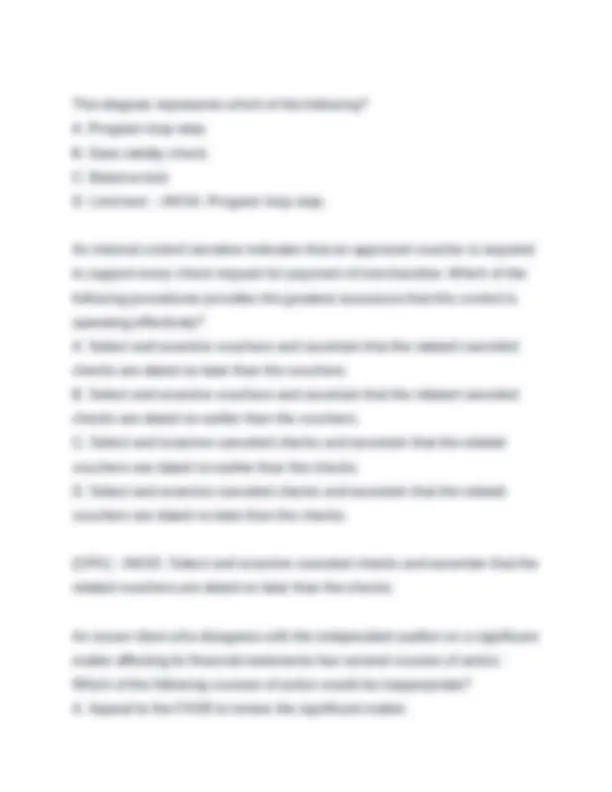
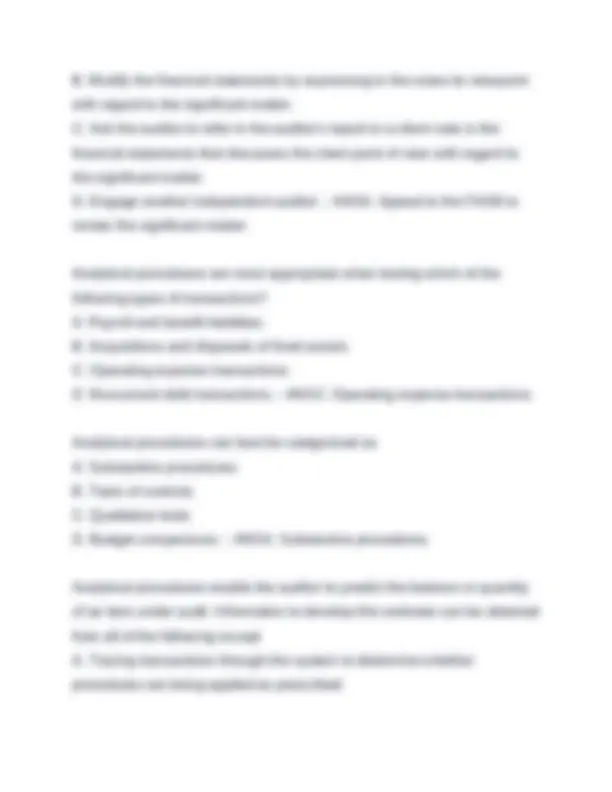
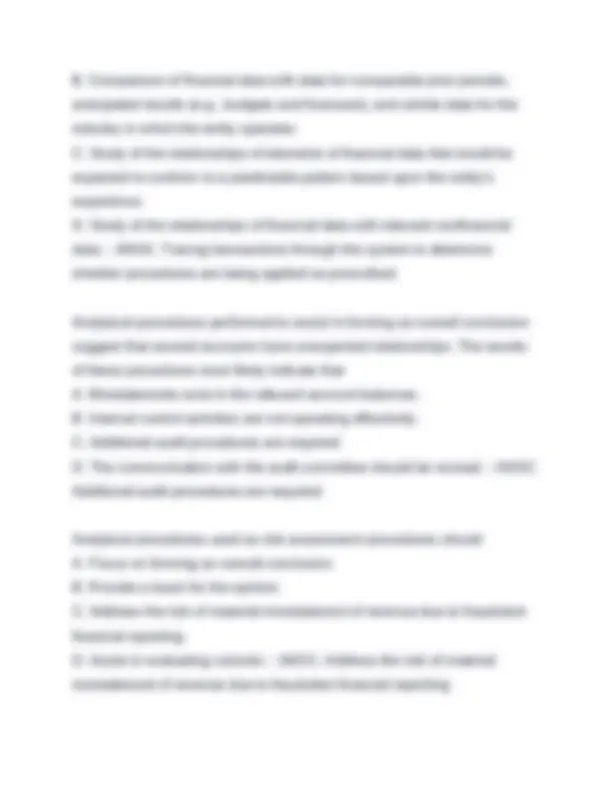
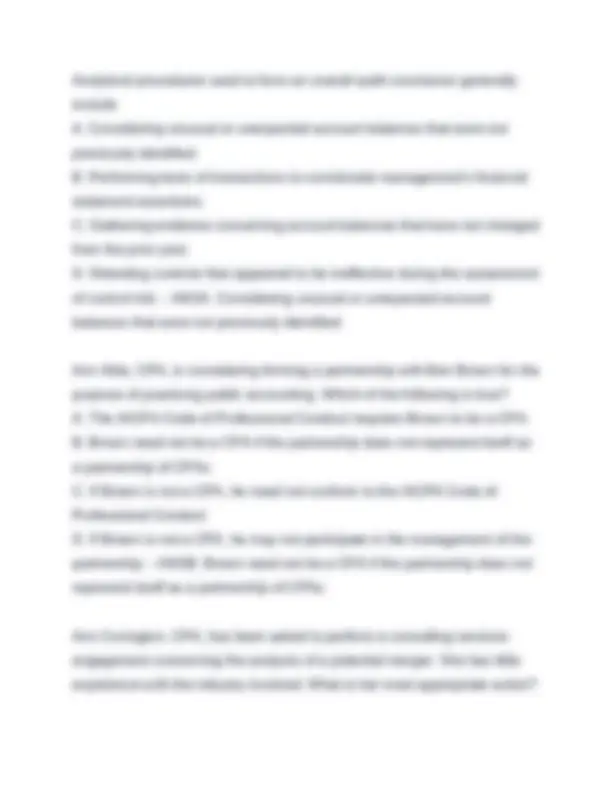
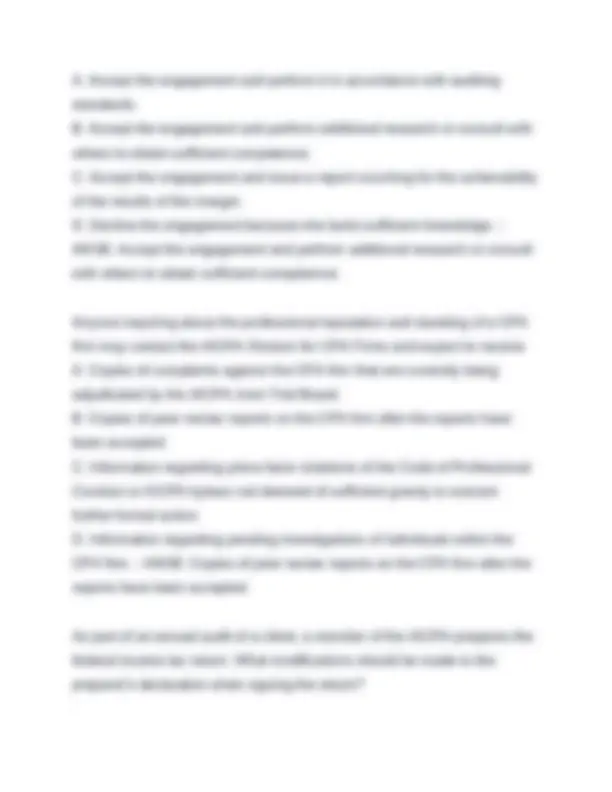
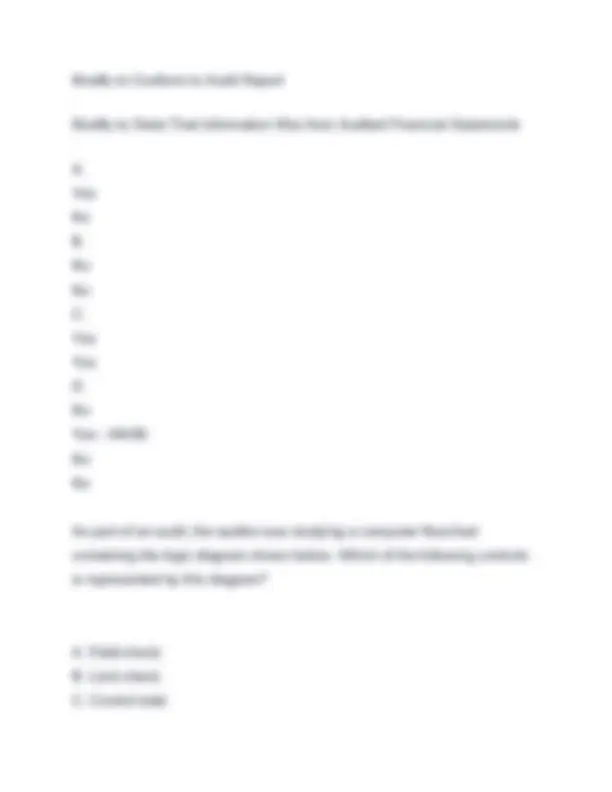
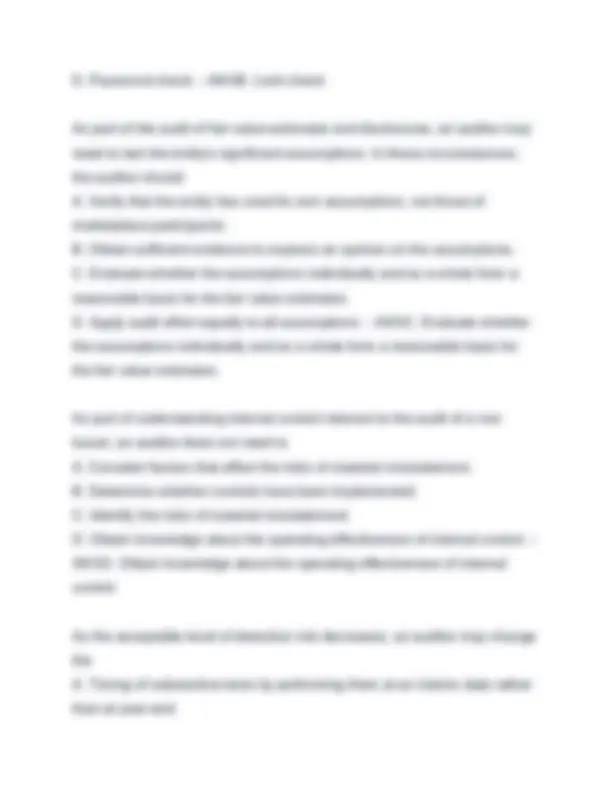
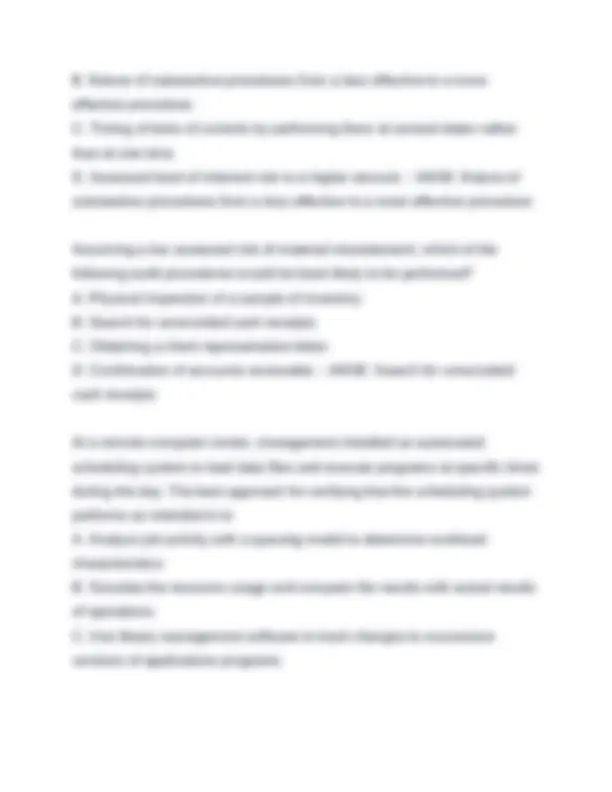
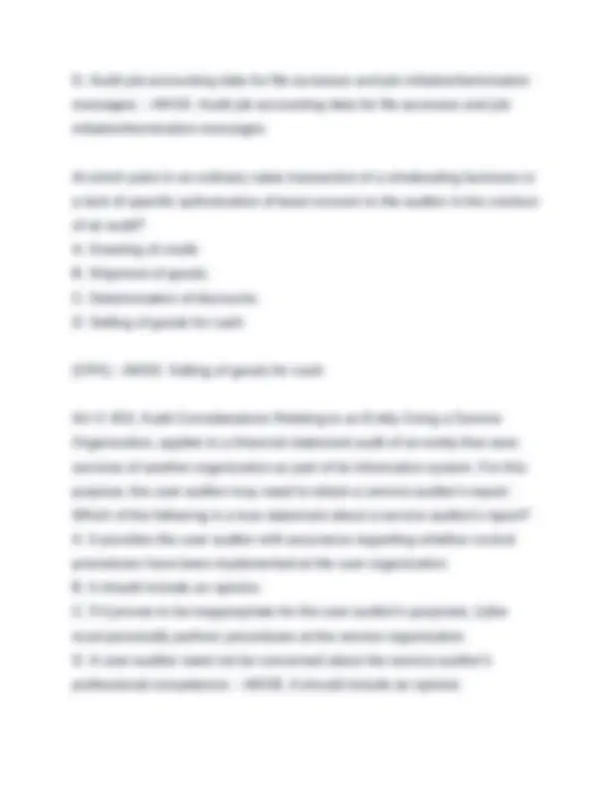
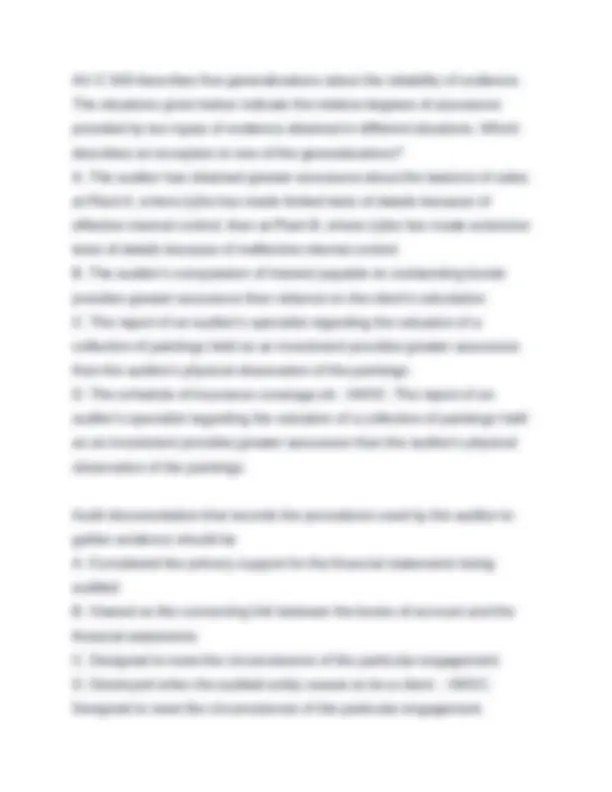
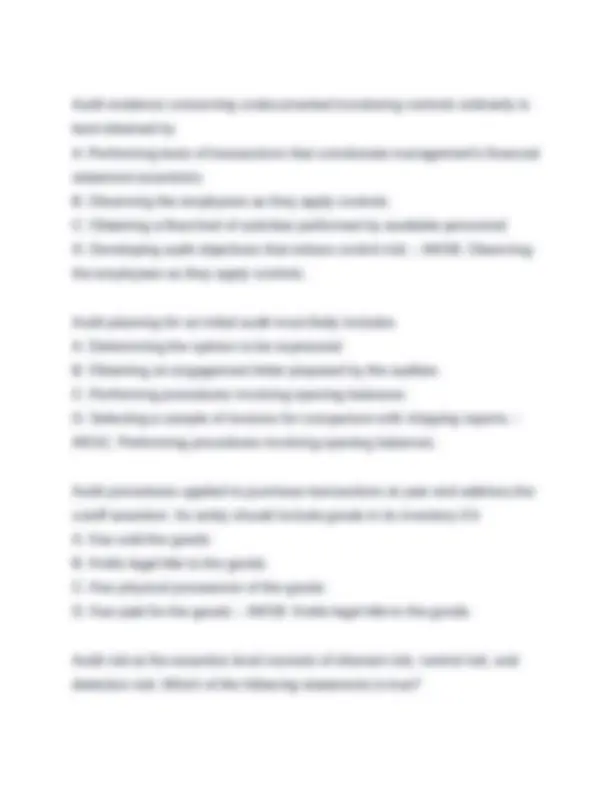
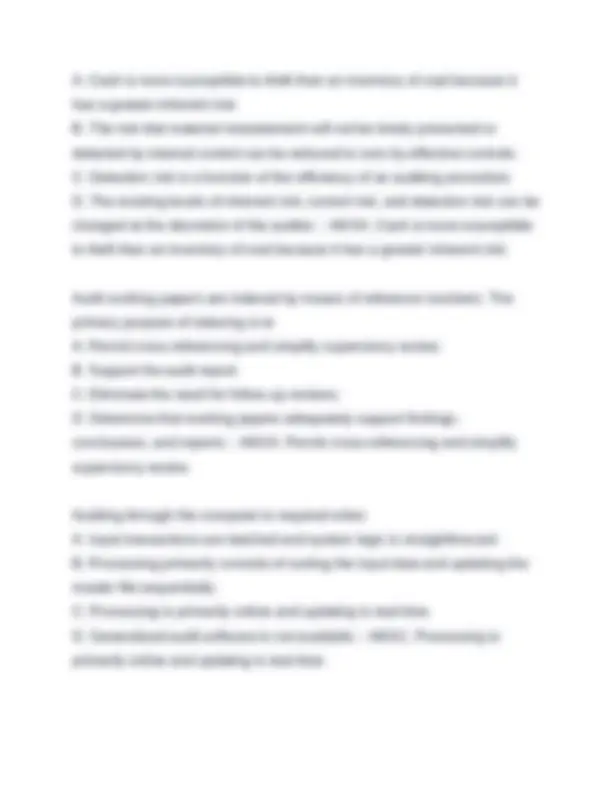
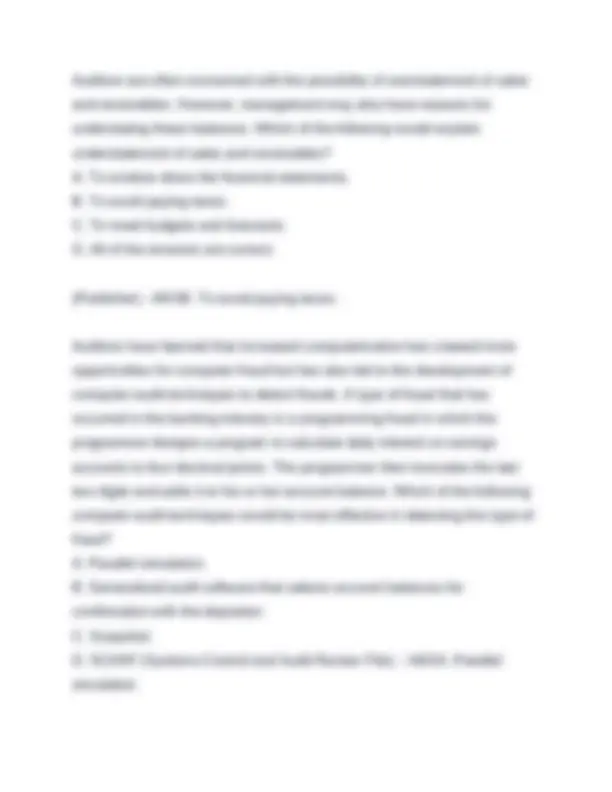
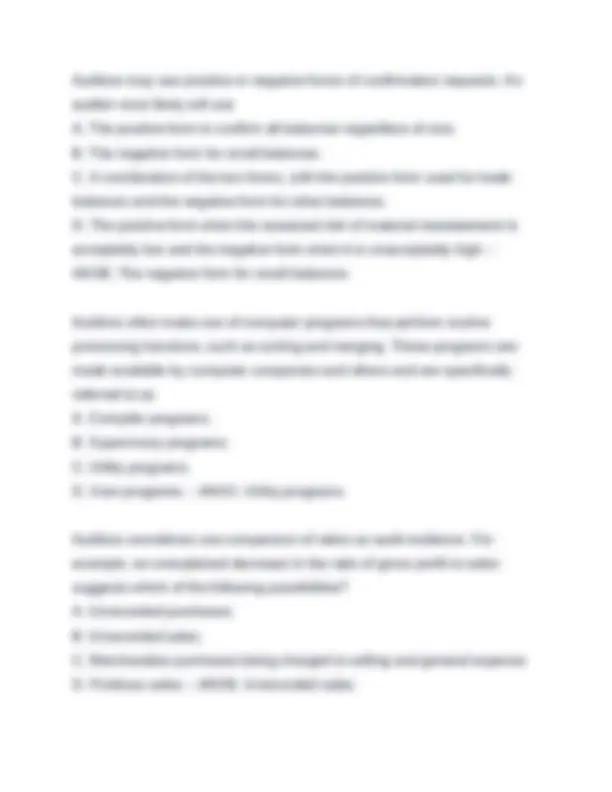
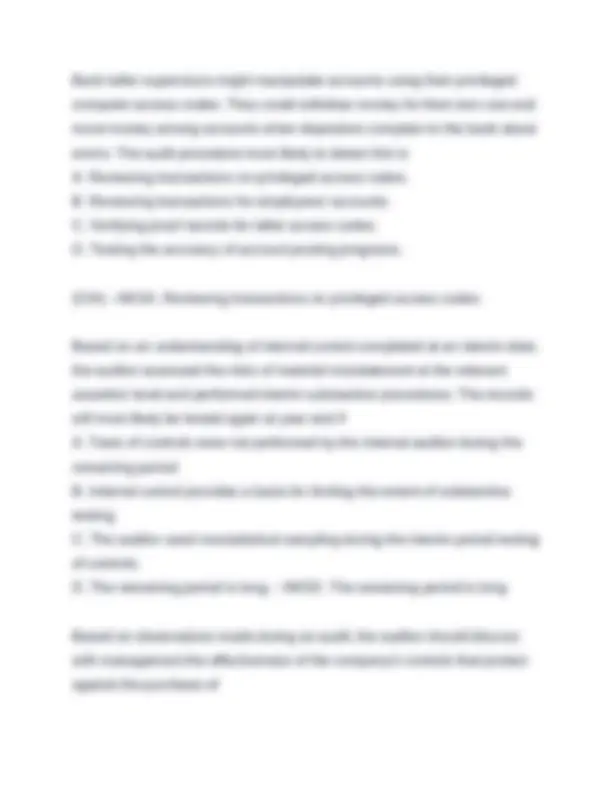
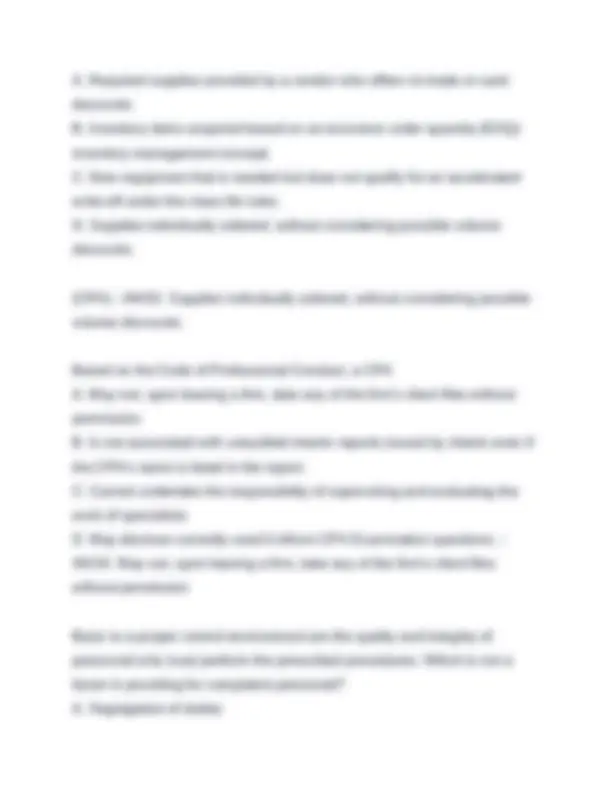
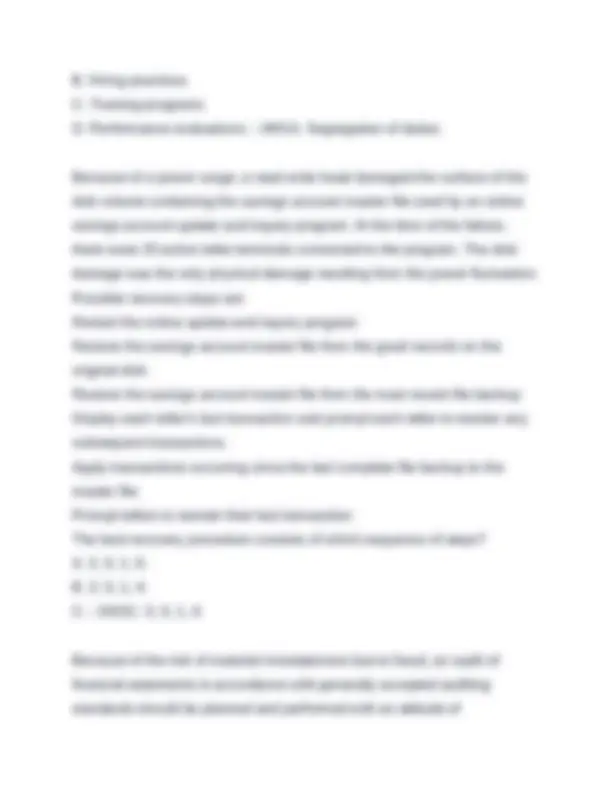


Study with the several resources on Docsity

Earn points by helping other students or get them with a premium plan


Prepare for your exams
Study with the several resources on Docsity

Earn points to download
Earn points by helping other students or get them with a premium plan
Community
Ask the community for help and clear up your study doubts
Discover the best universities in your country according to Docsity users
Free resources
Download our free guides on studying techniques, anxiety management strategies, and thesis advice from Docsity tutors
MGMT 443 - CH 10 to 16, Gleim Ch. 1 to 9 Test Bank Updated Version 2025-2026. Questions & Correct Answers. Graded A
Typology: Exams
1 / 341

This page cannot be seen from the preview
Don't miss anything!





























































































1.1.1. In performing an attest engagement, a CPA most likely A. Supplies litigation support services. B. Assesses the risks of material misstatement. C. Expresses an opinion or conclusion about a written assertion. D. Provides management consulting advice. - ANSC. Expresses an opinion or conclusion about a written assertion. 1.1.2. Which of the following professional services is considered an attest engagement? A. A consulting service engagement to provide computer advice to a client. B. An engagement to report on compliance with statutory requirements. C. An income tax engagement to prepare federal and state tax returns. D. The compilation of an engagement to provide a peer review for another CPA firm. - ANSB. An engagement to report on compliance with statutory requirements. 1.1.3. A financial forecast A. Is based on the most conservative estimates. B. Present estimates given one or more hypothetical assumptions. C. Unlike a projection, may contain a range.
D. Presents expected financial position, results of operations, and cash flows. - ANSD. Presents expected financial position, results of operations, and cash flows. 1.1.4. Which of the following is the authoritative body designated to promulgate attestation standards? A. Auditing Standards Board. B. Governmental Accounting Standards Board. C. Financial Accounting Standards Board. D. Government Accountability Office. - ANSA. Auditing Standards Board. 1.1.5. A CPA is required to comply with the provisions of Statements on Standards for Attestation Engagements (SSAE) when engaged to A. Report on financial statements that the CPA generated through the use of computer software. B. Review management's discussion and analysis (MD&A) prepared pursuant to rules and regulations adopted by the SEC. C. Provide the client with a financial statement format that does not include dollar amounts. D. Audit financial statements that the client prepared for use in another country. - ANSB. Review management's discussion and analysis (MD&A) prepared pursuant to rules and regulations adopted by the SEC. 1.1.6. Which of the following presents what the effects on historical financial data might have been if a consummated transaction had occurred at an earlier date? A. Prospective financial statements.
1.2.11. Which of the following statements best describes the primary purpose of Statements on Auditing Standards (SASs)? A. They are guides intended to set forth auditing procedures applicable to a variety of situations. B. They are procedural outlines intended to narrow the areas of inconsistency and divergence of auditor opinion. C. They are authoritative statements, enforced through the Code of Professional Conduct, and are intended to limit the degree of auditor judgment. D. They are generally accepted auditing standards. - ANSD. They are generally accepted auditing standards. 1.2.12. According to AU-C 200, Overall Objectives of the Independent Auditor and the Conduct of an Audit in Accordance with Generally Accepted Auditing Standards, "presumptively mandatory requirements" in the auditing standards use which word? A. Must. B. Can. C. Should. D. May. - ANSC. Should. 1.2.13. Auditing Interpretations are issued by the Audit Issues Task Force of the Auditing Standards Board (ASB) to provide timely guidance on the application of pronouncements of the ASB. They are A. Not auditing standards. B. Equally as authoritative as Statements on Auditing Standards. C. More authoritative than Statements on Auditing Standards.
D. Nonauthoritative opinions that are expressed without consulting the ASB. - ANSA. Not auditing standards 1.2.14. An auditor must obtain professional experience primarily to A. Receive a positive employment evaluation. B. Exercise professional judgment. C. Receive a favorable peer review. D. Earn a specialty designation by the AICPA. - ANSB. Exercise professional judgment. 1.2.15. Competence as an independent auditor includes all of the following except A. Having the technical qualifications to perform an engagement. B. Possessing the ability to supervise assistants. C. Warranting the infallibility of the work performed. D. Consulting others if additional technical information is needed. - ANSC. Warranting the infallibility of the work performed. 1.2.16. GAAS require the auditor to be independent. An auditor is independent if (s)he is A. Competent. B. Independent in fact and in appearance. C. Consistent and independent in fact. D. Logical and intellectually honest. - ANSB. Independent in fact and in appearance.
A. The extent to which the work of internal auditors will influence the scope of the audit. B. Details of the procedures that the auditor intends to apply. C. The extent to which change in the company's organization will influence the scope of the audit. D. Details of potential problems that the auditor believes might cause a qualified opinion. - ANSB. Details of the procedures that the auditor intends to apply. 1.2.2. Independent CPAs perform audits on the financial statements of issuers. This type of auditing can best be described as A. An activity whose purpose is to search for fraud. B. A discipline that attests to financial information presented by management. C. A professional activity that measures and communicates financial and business data. D. A regulatory function that prevents the issuance of improper financial information. - ANSB. A discipline that attests to financial information presented by management. 1.2.20. Through legal precedent, generally accepted auditing standards established by the AICPA apply A. Only to CPAs who belong to local CPA societies. B. To all CPAs. C. Only to those CPAs who choose to have quality reviews. D. Only to CPAs conducting audits subject to AICPA jurisdiction. - ANSB. To all CPAs.
1.2.21. Audit standards require that the engagement partner A. Examine all available corroborating evidence. B. Be responsible for the assignment of tasks to, and supervision of, assistants. C. Review evidence and audit documentation once the report has been issued. D. Design the audit to detect all instances of noncompliance with laws and regulations having direct effects on the determination of material financial statement amounts and disclosures. - ANSB. Be responsible for the assignment of tasks to, and supervision of, assistants. 1.2.22. Several sources of U.S. GAAP consulted by an auditor are in conflict as to the application of an accounting principle. Which of the following should the auditor consider the most authoritative? A. FASB Accounting Standards Codification. B. International Financial Reporting Standards (IFRS). C. FASB Statements of Financial Accounting Concepts. D. AICPA Issues Papers. - ANSA. FASB Accounting Standards Codification. 1.2.3. Who establishes generally accepted auditing standards? A. Auditing Standards Board and the Public Company Accounting Oversight Board. B. Financial Accounting Standards Board and the Governmental Accounting Standards Board. C. State Boards of Accountancy.
1.2.7. Brandnew Company is going public, and its stock will be listed on a stock exchange. Audited financial statements are required to be filed with the Securities and Exchange Commission (SEC). Who is expected to be the primary user of the audited financial statements? A. The stock exchange. B. Brandnew Company's investors. C. The SEC. D. Brandnew Company's board of directors. - ANSB. Brandnew Company's investors. 1.2.8. The Committee of Sponsoring Organizations (COSO) of the Treadway Commission issued a document in 1992 (subsequently updated) that has been embraced by numerous organizations, including the AICPA and the GAO. That document is titled A. The Yellow Book. B. Internal Control--Integrated Framework. C. Statements on Auditing Standards. D. Code of Professional Conduct. - ANSB. Internal Control--Integrated Framework. 1.2.9. The authoritative body designated to promulgate standards concerning an accountant's association with unaudited financial statements of an entity that is not required to file financial statements with an agency regulating the issuance of the entity's securities is the A. Financial Accounting Standards Board. B. Government Accountability Office. C. Accounting and Review Services Committee.
D. Auditing Standards Board. - ANSC. Accounting and Review Services Committee. 1.3.1. Which of the following services, if any, may an accountant who is not independent provide? A. Compilations but not reviews. B. Reviews but not compilations. C. Both compilations and reviews. D. Neither reviews nor compilations. - ANSA. Compilations but not reviews. 1.3.2. Statements on Standards for Accounting and Review Services establish standards and procedures for which of the following engagements? A. Assisting in adjusting the books of account for a partnership. B. Reviewing interim financial information required to be filed by public companies with the SEC. C. Processing financial data for clients of other accounting firms. D. Compiling an individual's personal financial statement to be used to obtain a mortgage. - ANSD. Compiling an individual's personal financial statement to be used to obtain a mortgage. 1.3.3. A CPA in public practice is required to comply with the provisions of the Statements on Standards for Accounting and Review Services when Advising a client Advocating a
B. One that makes a filing with a regulatory agency in preparation for a sale of any class of securities to the public. C. A subsidiary, corporate joint venture, or other entity controlled by an issuer. D. A closely held corporation. - ANSD. A closely held corporation. 1.3.5. The guidance least likely to apply to personal financial planning (PFP) engagements is A. Confidential Client Information Rule. B. Independence Rule. C. Statement on Standards for Consulting Services. D. Statement on Standards for Attestation Engagements related to financial forecasts and projections. - ANSB. Independence Rule. 1.3.6. The practitioner's report on the examination of prospective financial statements should include all of the following except A. An identification of the prospective financial statements presented and a statement that the examination was made in accordance with AICPA attestation standards. B. A statement that the practitioner assumes no responsibility to update the report for events and circumstances after the report date. C. The practitioner's opinion that the statements are in conformity with AICPA presentation guidelines and that the underlying assumptions provide a reasonable basis for the projection given the hypothetical assumptions or a reasonable basis for the forecast.
D. The practitioner's opinion that the prospective results will be attained. - ANSD. The practitioner's opinion that the prospective results will be attained. 1.4.1. Assurance services are best described as A. Services designed for the improvement of operations, resulting in better outcomes. B. Independent professional services that improve the quality of information, or its context, for decision makers. C. The assembly of financial statements based on information and assumptions of a responsible party. D. Services designed to express an opinion on historical financial statements based on the results of an audit. - ANSB. Independent professional services that improve the quality of information, or its context, for decision makers. 1.4.2. Assurance services differ from consulting services in that they Focus on Providing Advice Involve Monitoring of One Party by Another A. Yes Yes B. Yes
A basic premise underlying analytical procedures is that A. These procedures cannot replace tests of balances and transactions. B. Statistical tests of financial information may lead to the discovery of material misstatements in the financial statements. C. The study of financial ratios is an acceptable alternative to the investigation of unusual fluctuations. D. Plausible relationships among data may reasonably be expected to exist and continue in the absence of known conditions to the contrary. - ANSD. Plausible relationships among data may reasonably be expected to exist and continue in the absence of known conditions to the contrary. A client decides not to correct misstatements communicated by the auditor that collectively are not material and wants the auditor to issue the report based on the uncorrected numbers. Which of the following statements is correct regarding the financial statement presentation? A. The financial statements are free from material misstatement, and no disclosure is required in the notes to the financial statements. B. The financial statements are not in accordance with the applicable financial reporting framework. C. The financial statements contain uncorrected misstatements that should result in a qualified opinion. D. The financial statements are free from material misstatement, but disclosure of the proposed adjustments is required in the notes to the financial statements. - ANSA. The financial statements are free from material misstatement, and no disclosure is required in the notes to the financial statements.
A client is a defendant in a patent infringement lawsuit against a major competitor. Which of the following items would least likely be included in legal counsel's response to the auditor's letter of inquiry? A. A description of potential litigation in other matters unrelated to the patent infringement lawsuit. B. A discussion of case progress and the strategy currently in place by client management to resolve the lawsuit. C. An evaluation of the probability of loss and a statement of the amount or range of loss if an unfavorable outcome is reasonably possible. D. An evaluation of the ability of the client to continue as a going concern if the verdict is unfavorable and maximum damages are awarded. (CPA) - ANSD. An evaluation of the ability of the client to continue as a going concern if the verdict is unfavorable and maximum damages are awarded. A client maintains a large data center where access is limited to authorized employees. How may an auditor best determine the effectiveness of this control activity? A. Inspect the policy manual establishing this control activity. B. Ask the chief technology officer about known problems. C. Observe whether the data center is monitored. D. Obtain a list of current data center employees. - ANSC. Observe whether the data center is monitored.
A client uses a suspense account for unresolved questions whose final accounting has not been determined. If a balance remains in the suspense account at year-end, the auditor would be most concerned about A. Suspense debits that management believes will benefit future operations. B. Suspense debits that the auditor verifies will have realizable value to the client. C. Suspense credits that management believes should be classified as "current liability." D. Suspense credits that the auditor determines to be customer deposits. - ANSA. Suspense debits that management believes will benefit future operations. A client's program that recorded receiving report information entered directly by the receiving department on vendor shipment receipt included a reasonableness or limit test. Which of the following errors would this test likely detect? A. The receipt was for a shipment from an unauthorized vendor. B. The vendor shipped the wrong item. C. The receiving department clerk entered the quantity of the product received as 0. D. The shipment received from the vendor was past due by 2 weeks. - ANSC. The receiving department clerk entered the quantity of the product received as 0. A company has computerized sales and cash receipts journals. The computer programs for these journals have been properly debugged. The
auditor discovered that the total of the accounts receivable subsidiary accounts differs materially from the accounts receivable control account. This discrepancy could indicate A. Credit memoranda being improperly recorded. B. Lapping of receivables. C. Receivables not being properly aged. D. Statements being intercepted prior to mailing. (CIA) - ANSA. Credit memoranda being improperly recorded. A company updates its accounts receivable master file weekly and retains the master files and corresponding update transactions for the most recent 2-week period. The purpose of this practice is to A. Verify run-to-run control totals for receivables. B. Match internal labels to avoid writing on the wrong volume. C. Permit reconstruction of the master file if needed. D. Validate groups of update transactions for each version. - ANSC. Permit reconstruction of the master file if needed. A company using EDI made it a practice to track the functional acknowledgments from trading partners and to issue warning messages if acknowledgments did not occur within a reasonable length of time. What risk was the company attempting to address by this practice? A. Transactions that have not originated from a legitimate trading partner may be inserted into the EDI network. B. Transmission of EDI transactions to trading partners may sometimes fail.